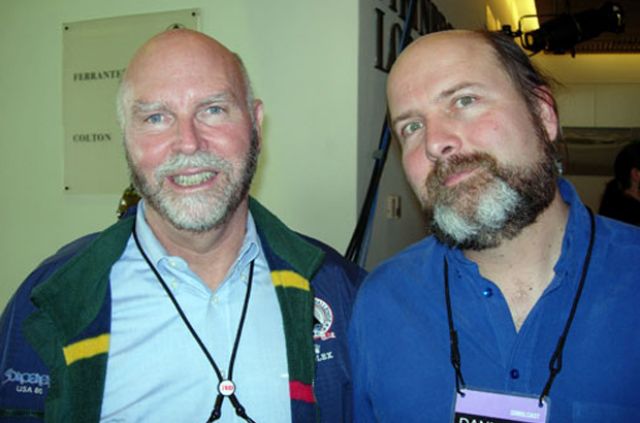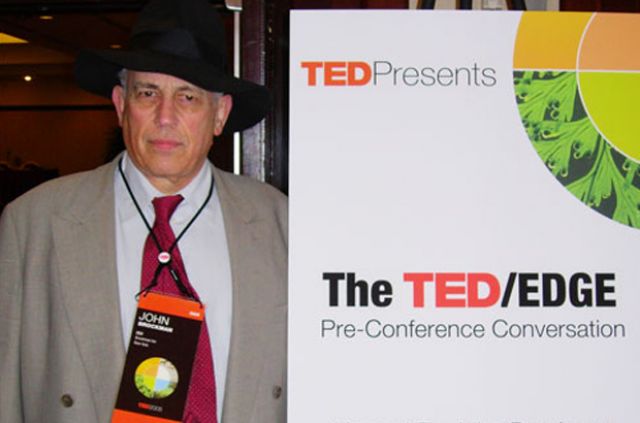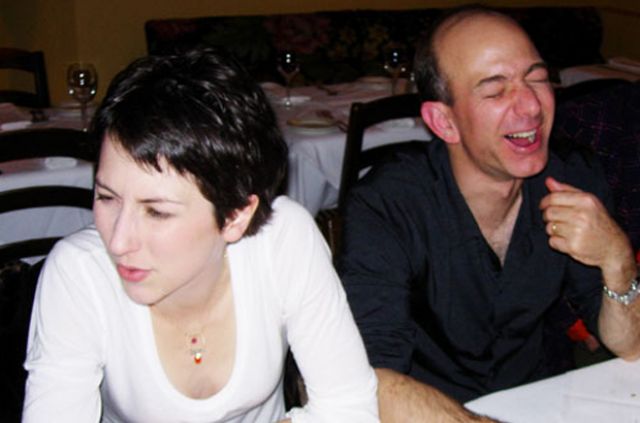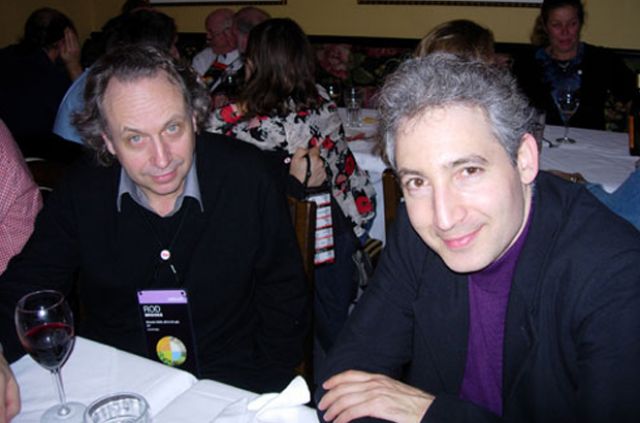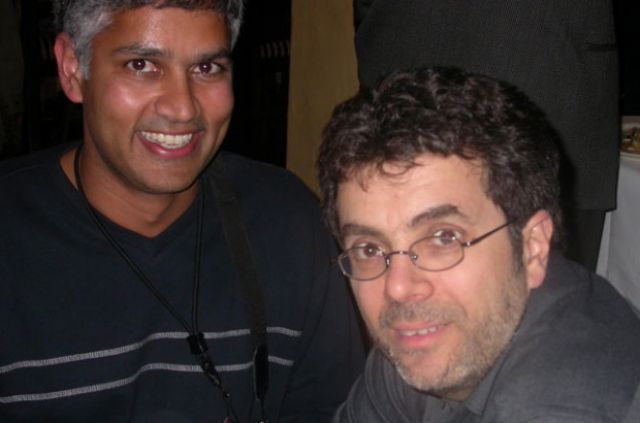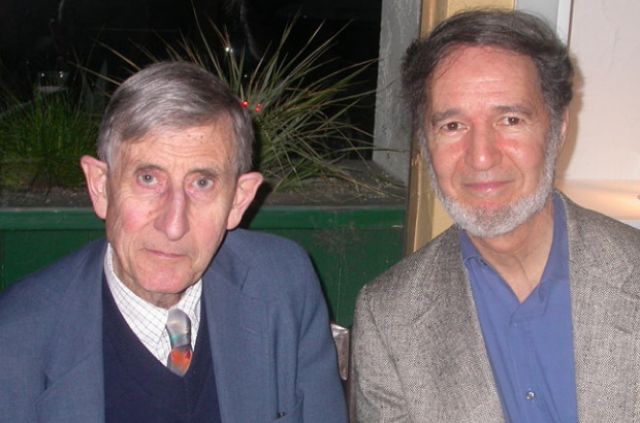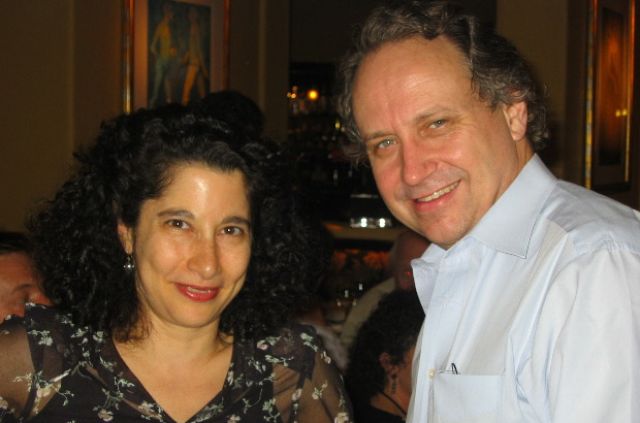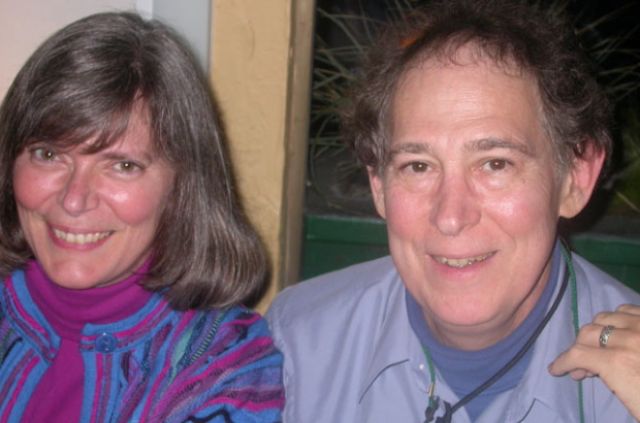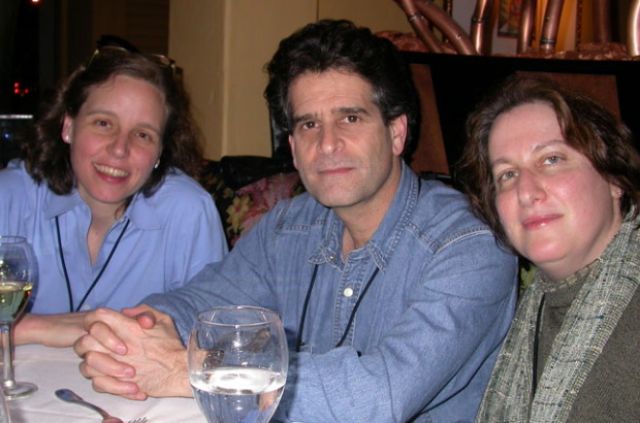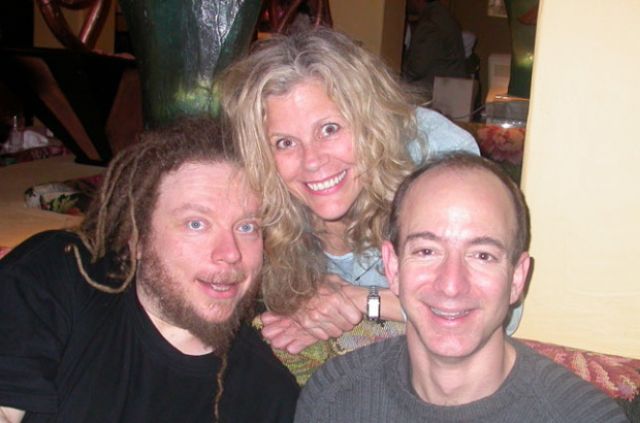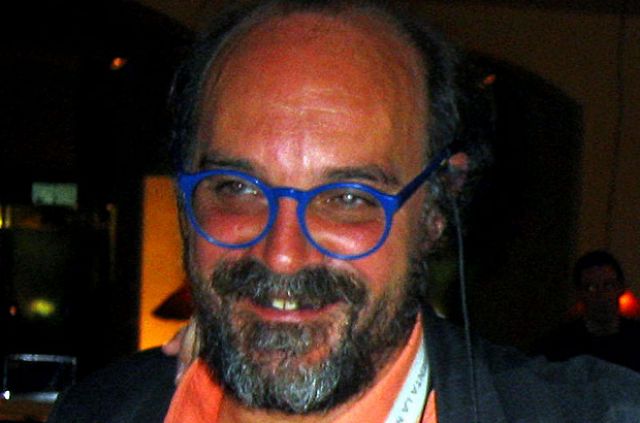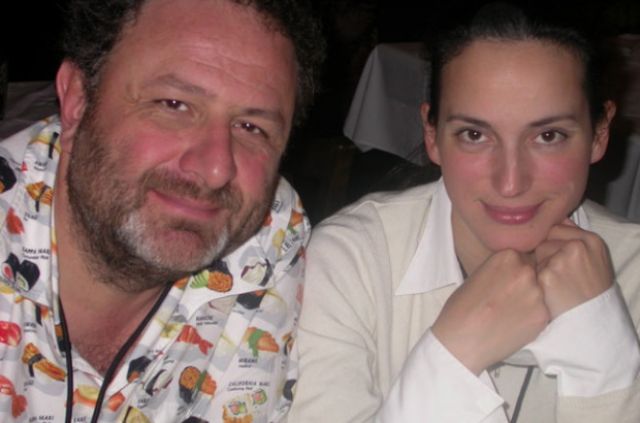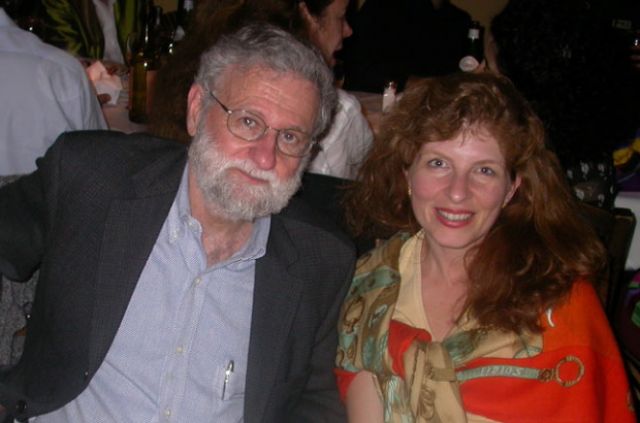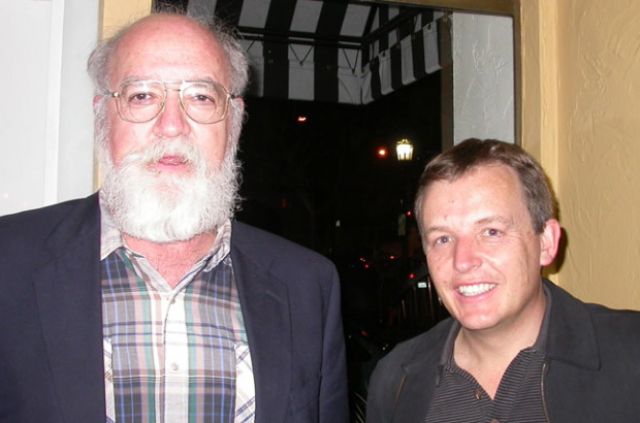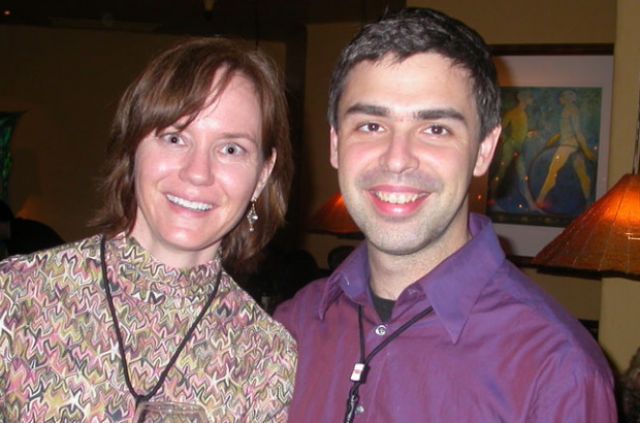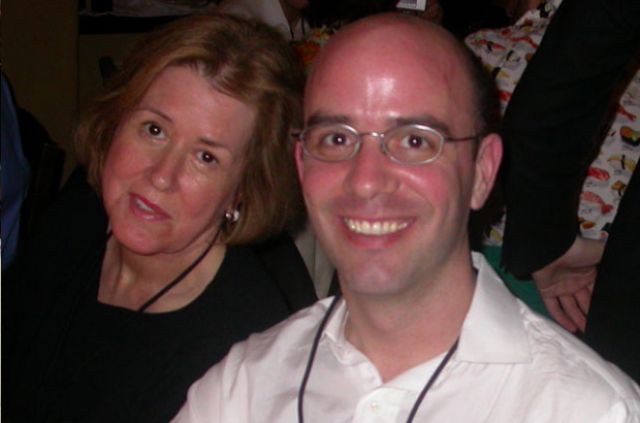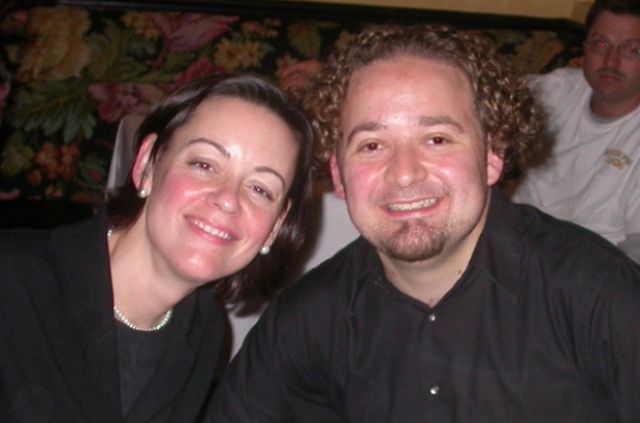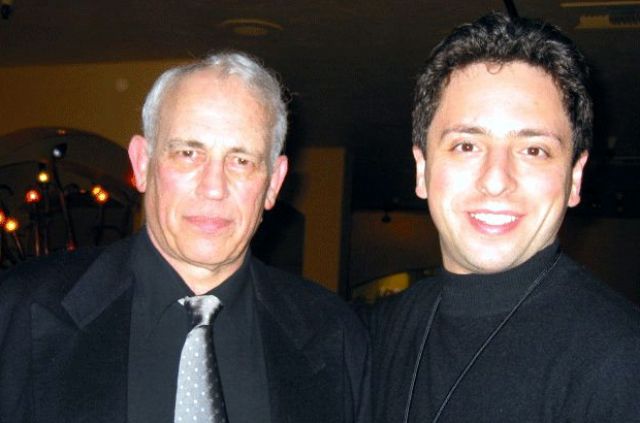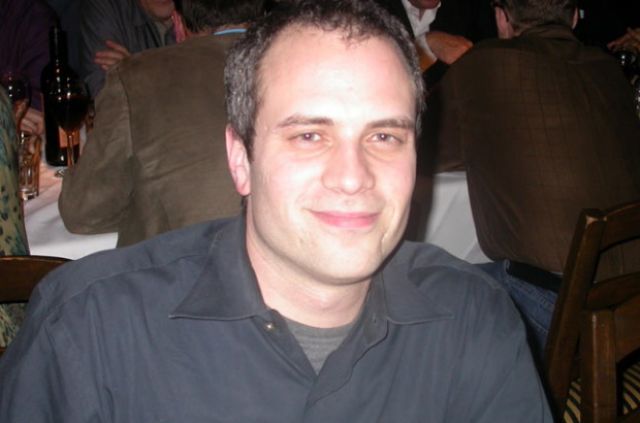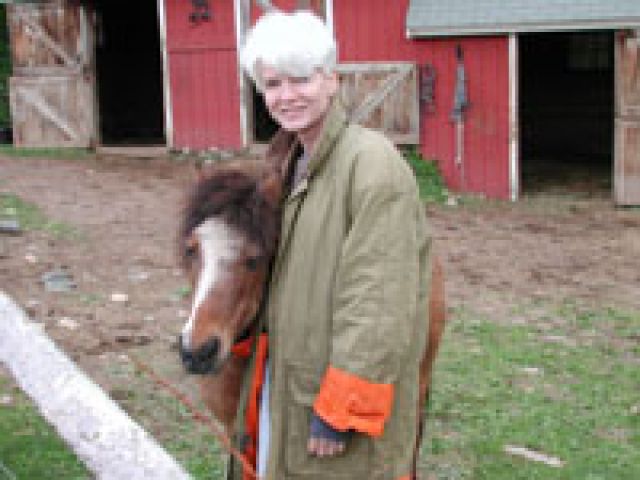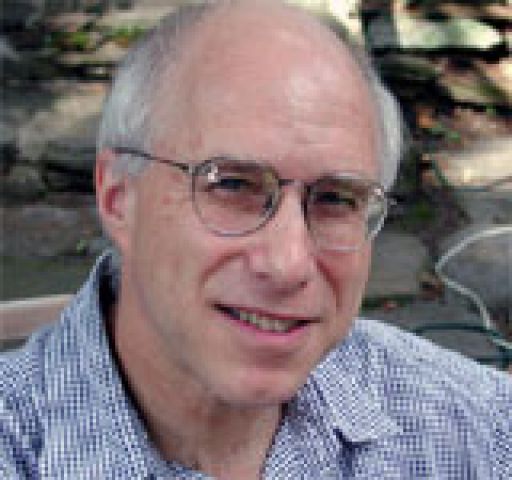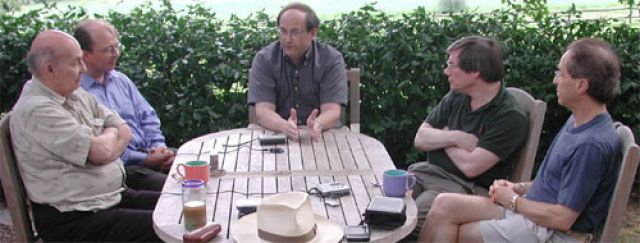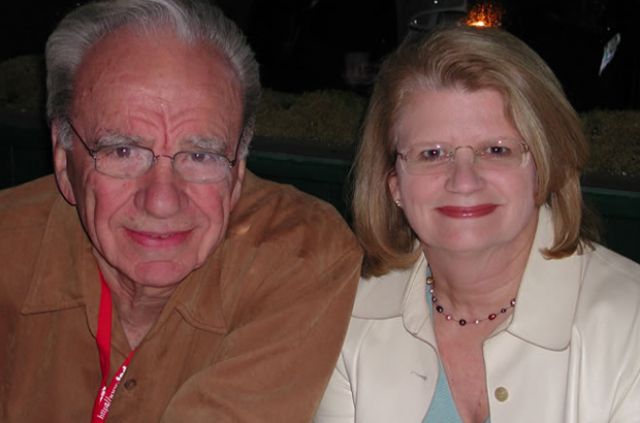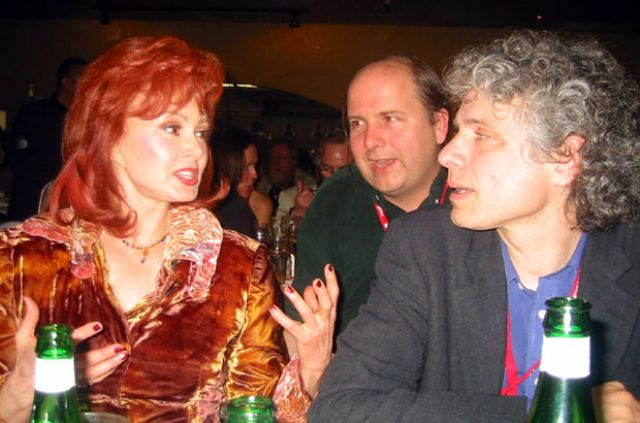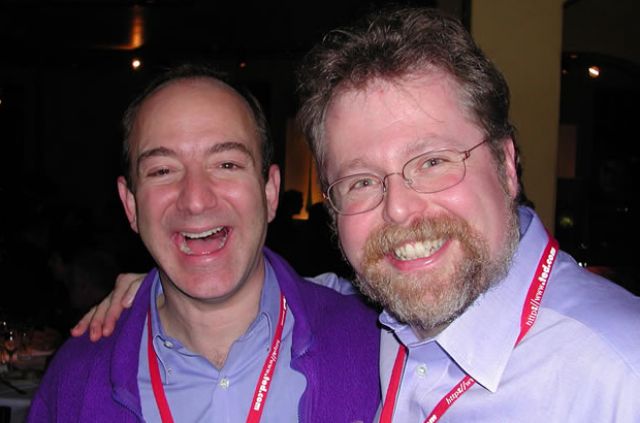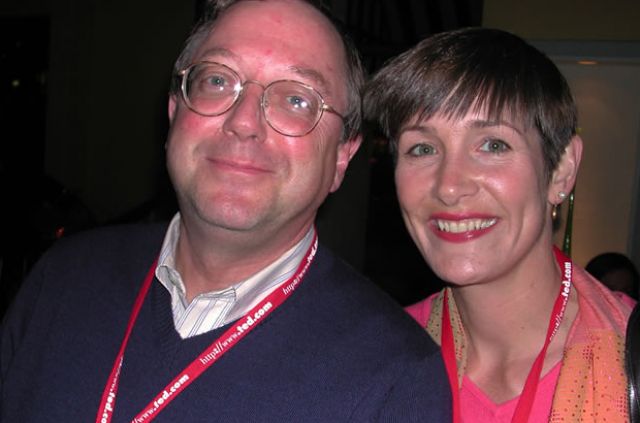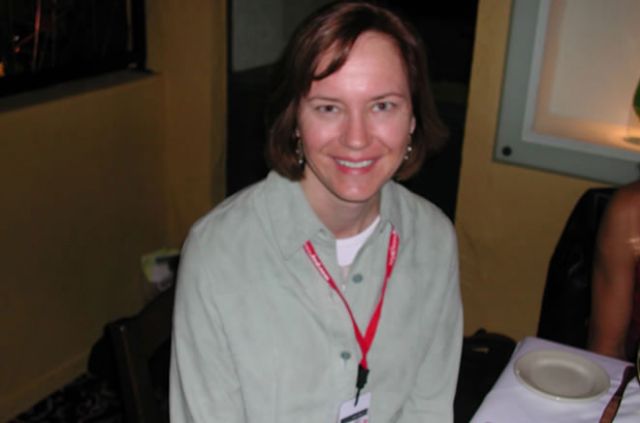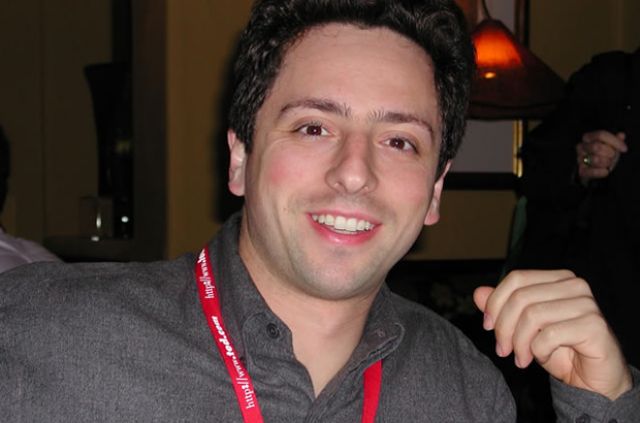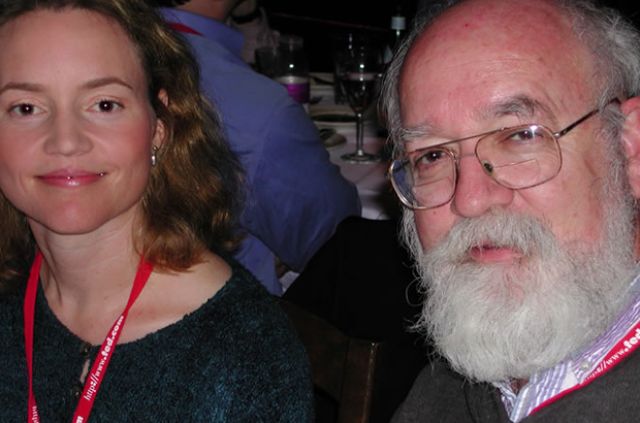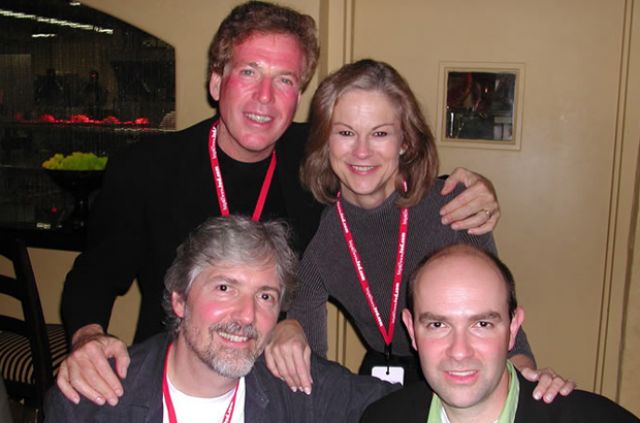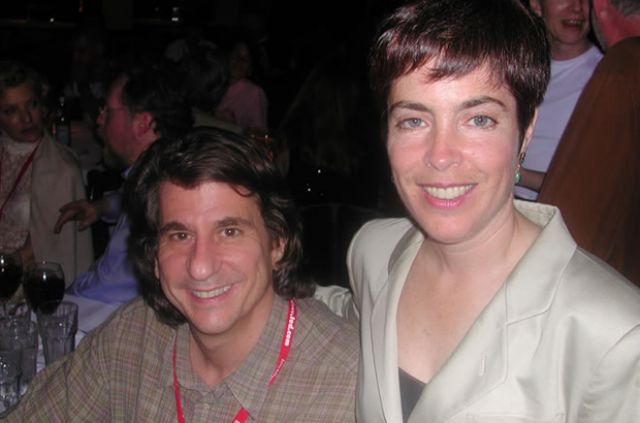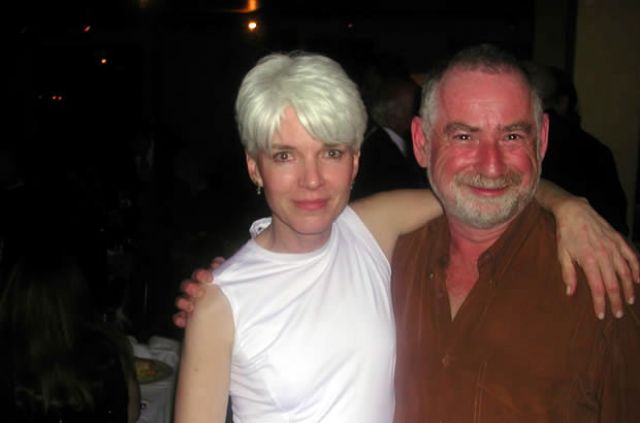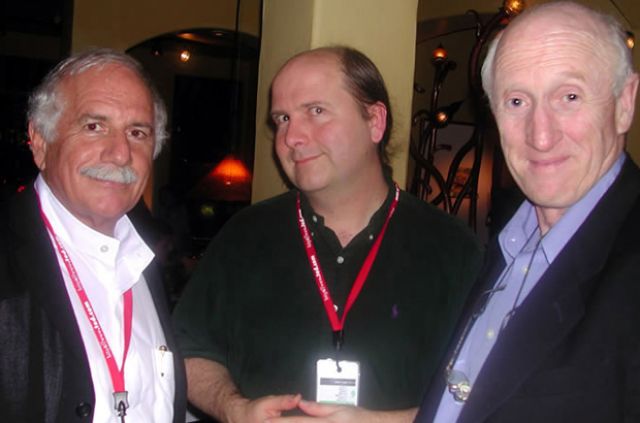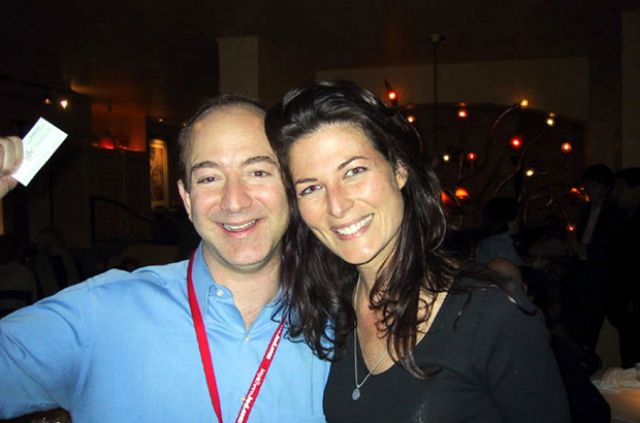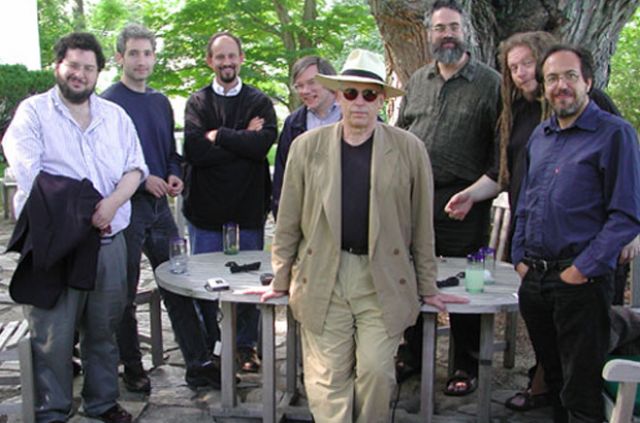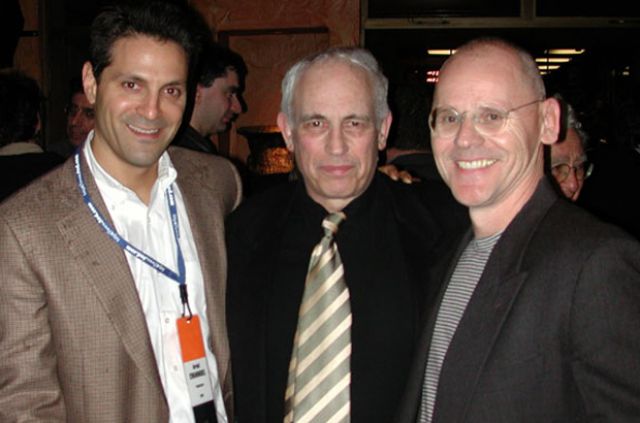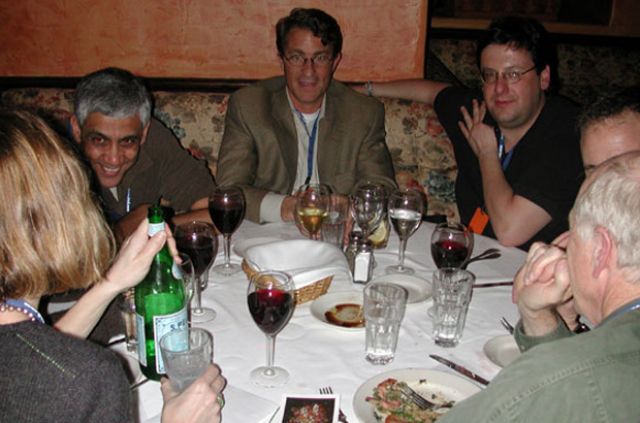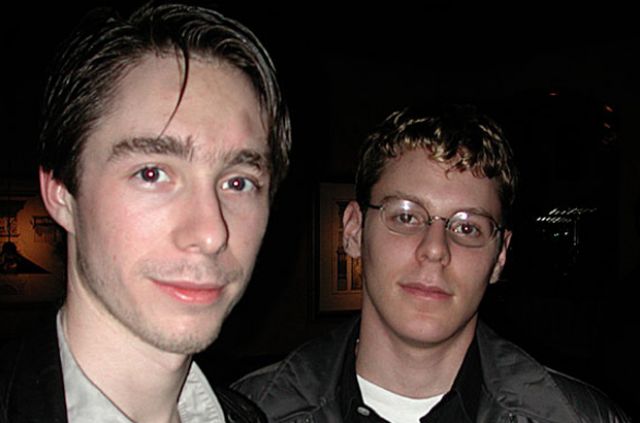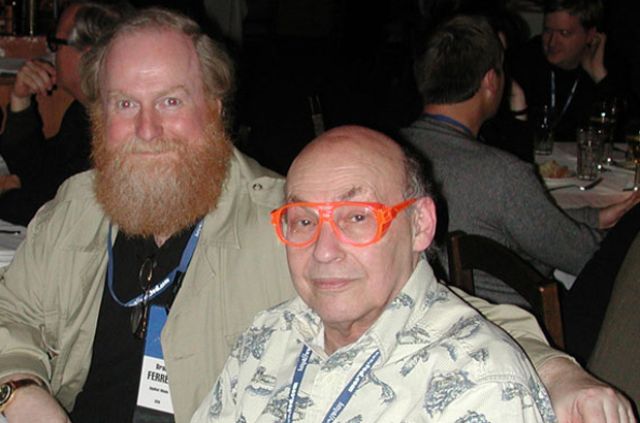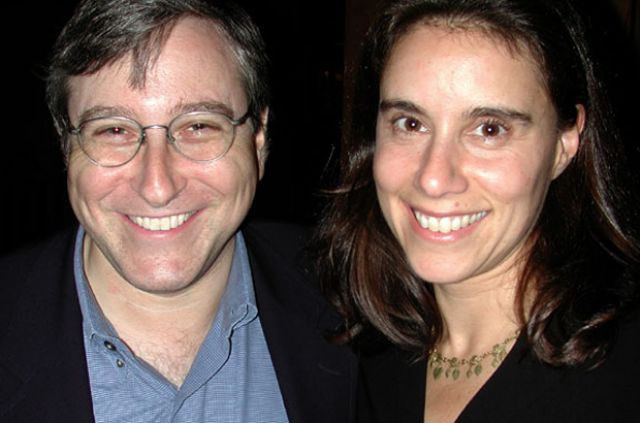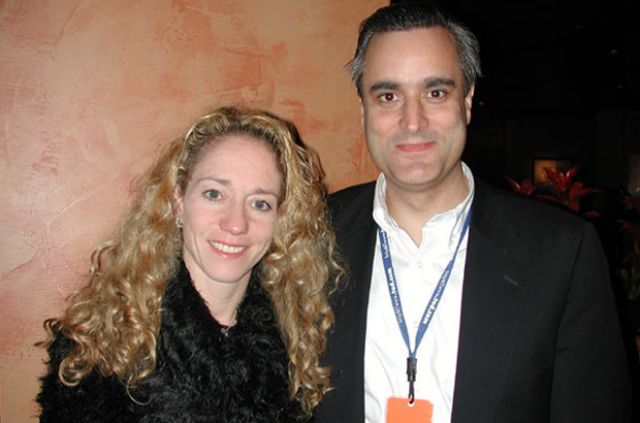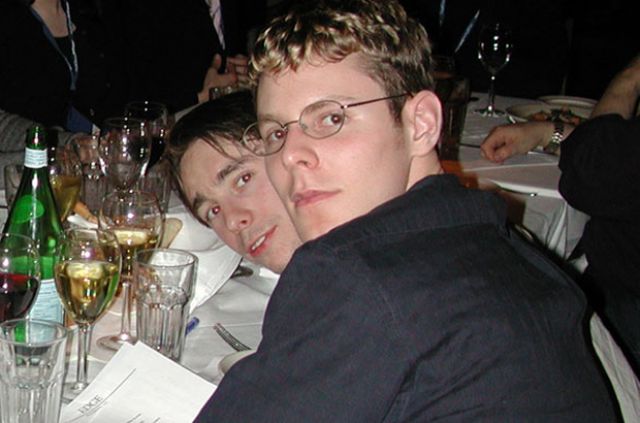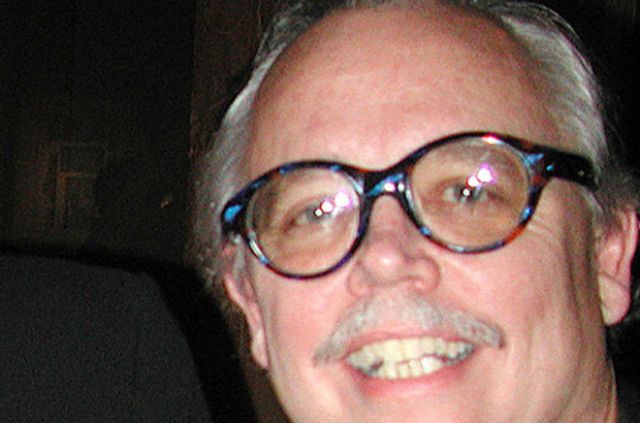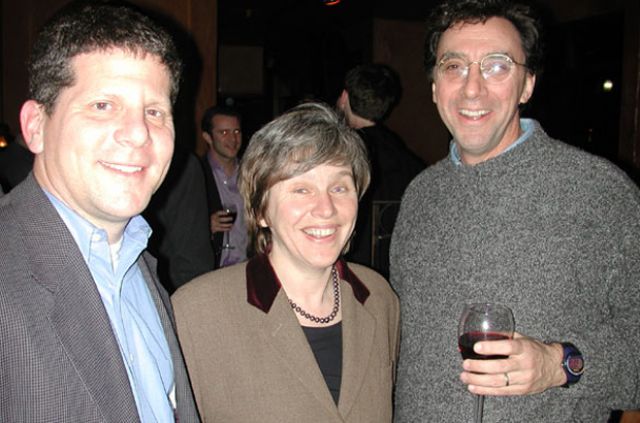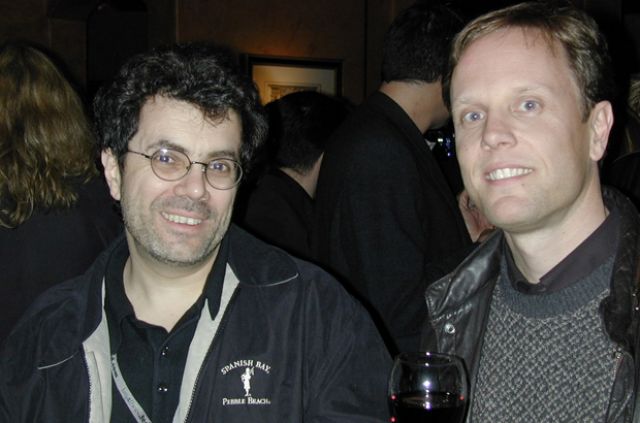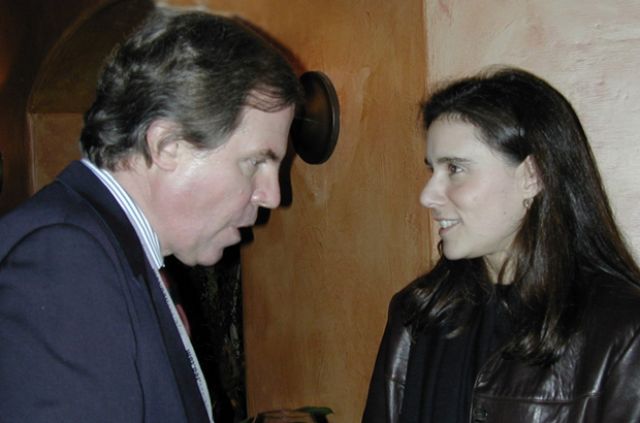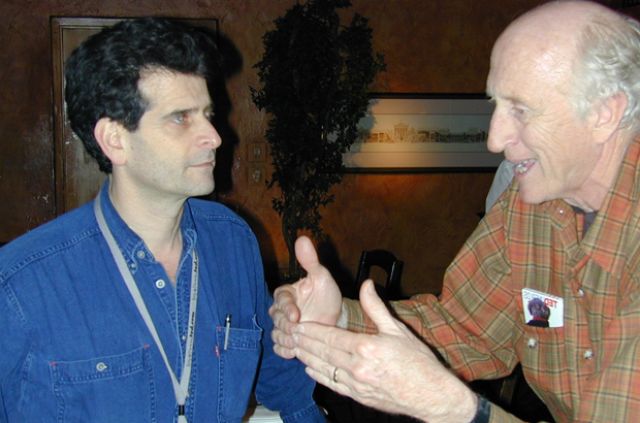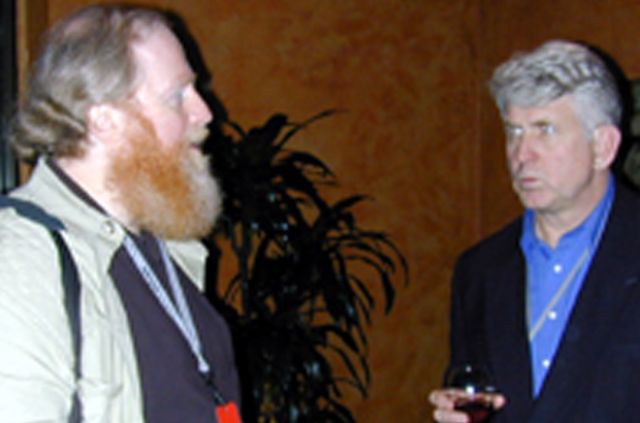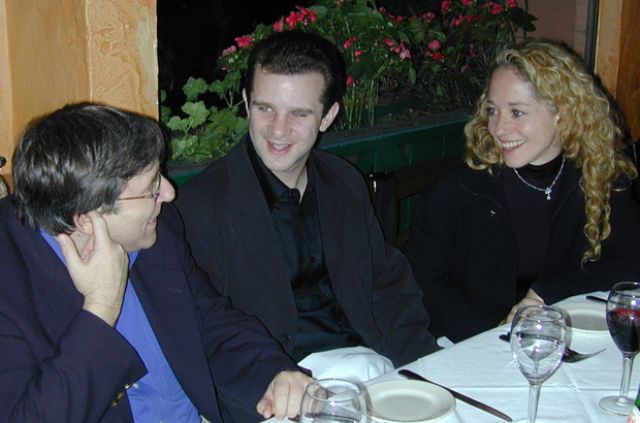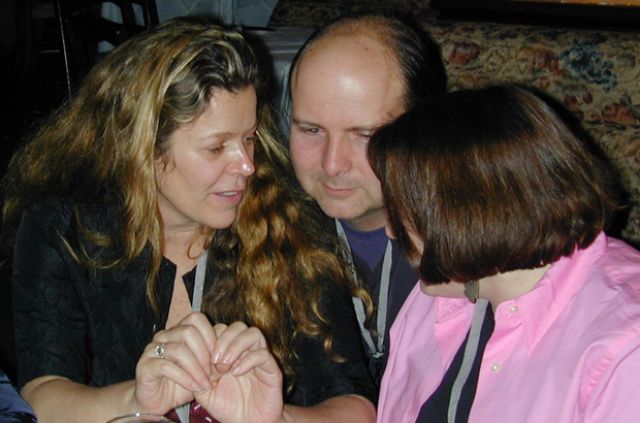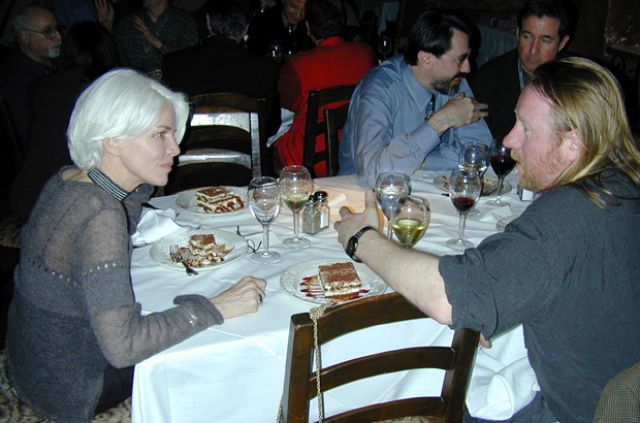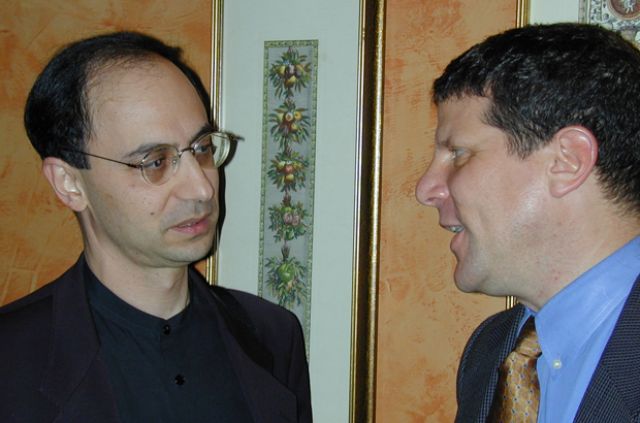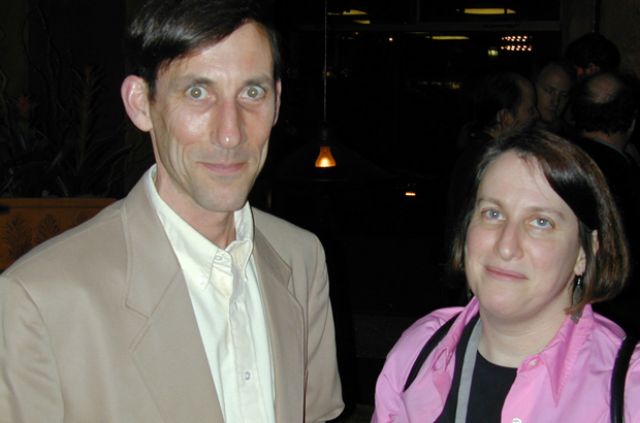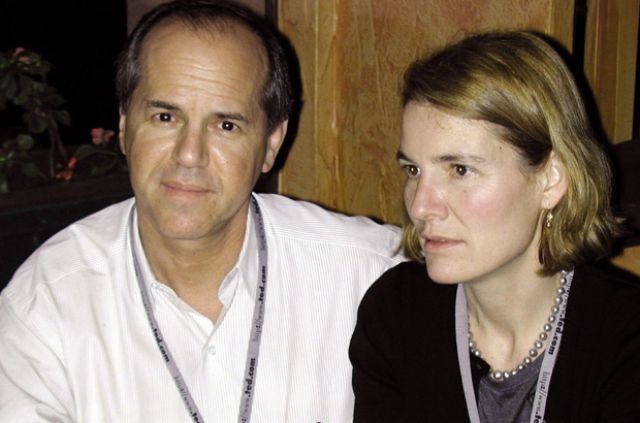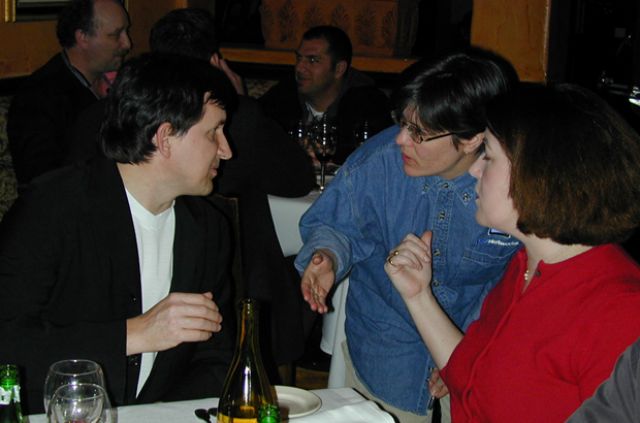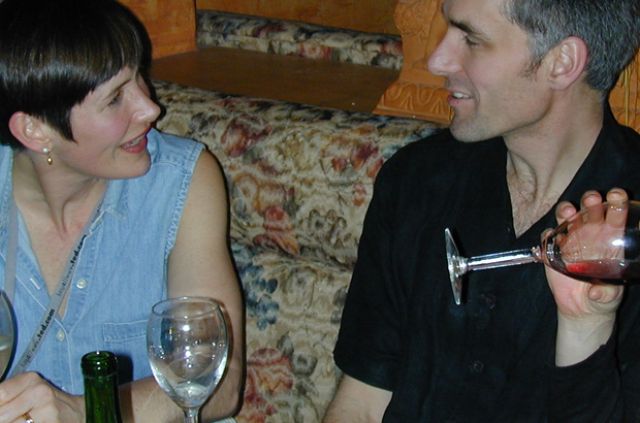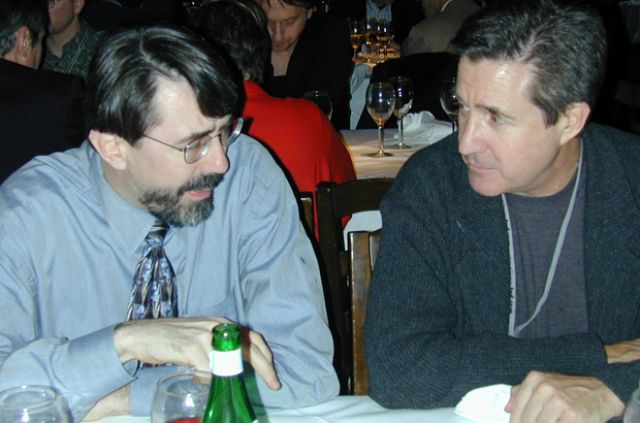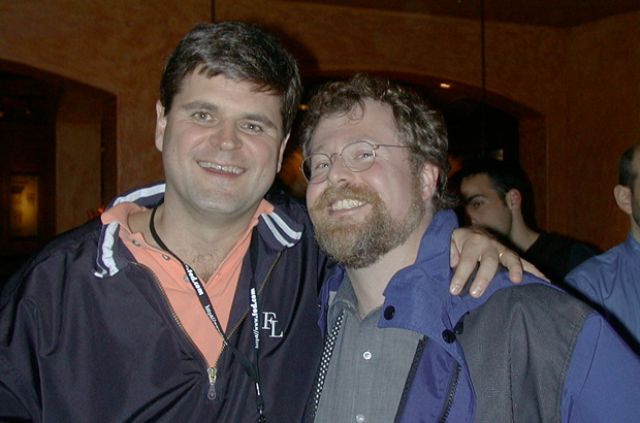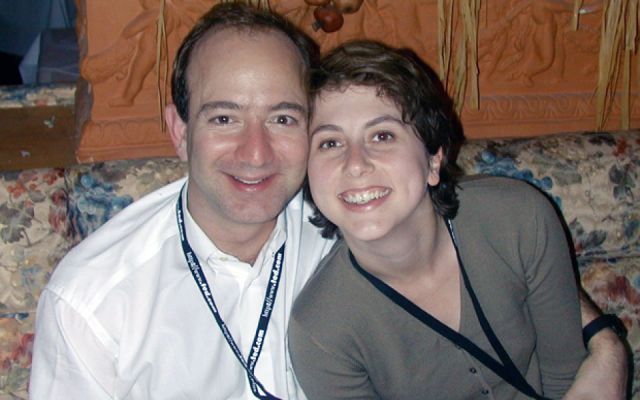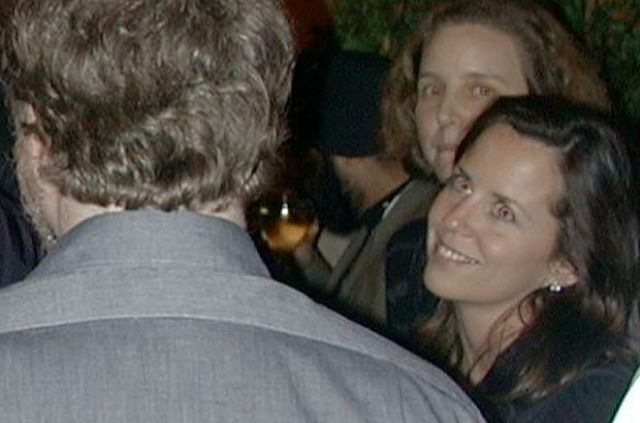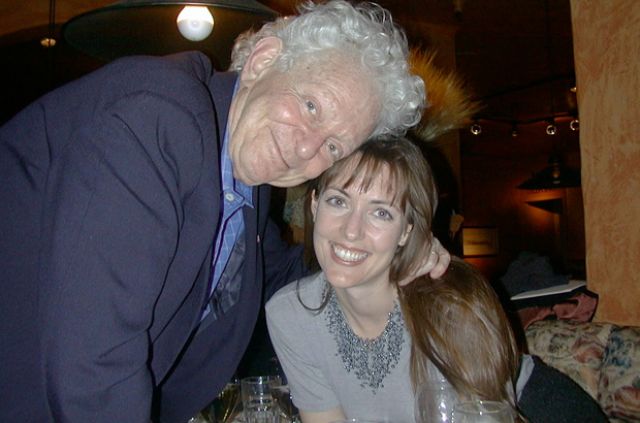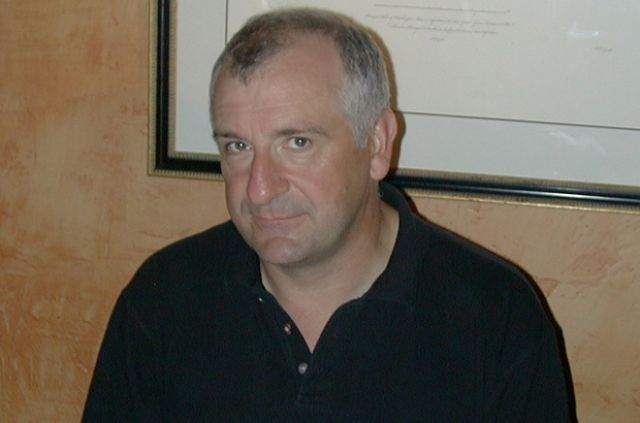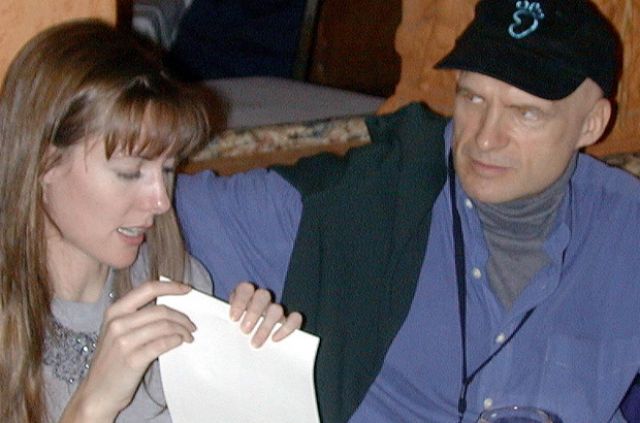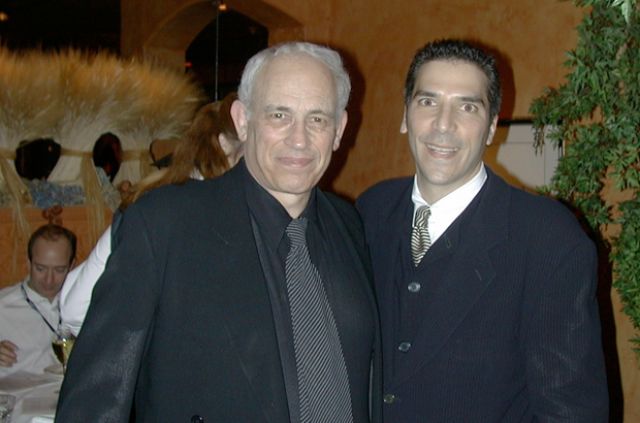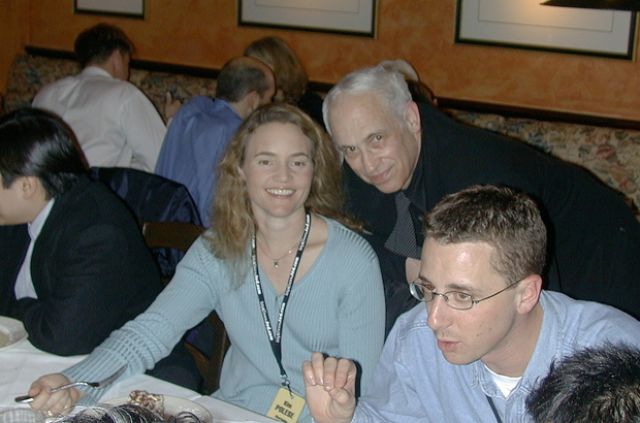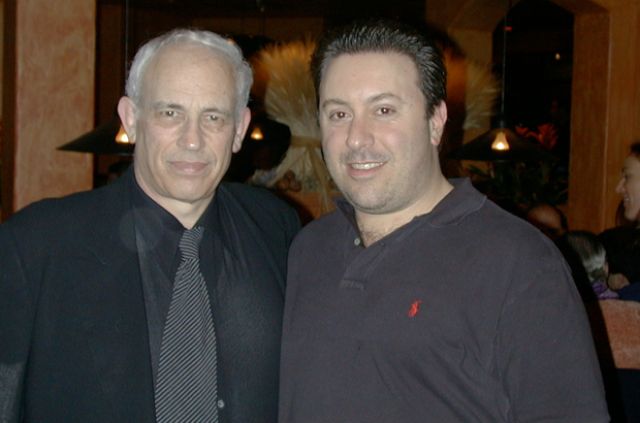"This goes beyond all known schmoozing.
This is like some kind of virtual-intellectual conspiracy-in-restraint-of-trade."
— Bruce Sterling, "Third Culture Schmoozing"
"The dinner party was a microcosm of a newly dominant sector of American business." — Wired
There's no such thing as a free lunch, or a free Billionaires' Dinner.

Ariane de Bonvoisin - Daniel Gilbert - Eva Wisten?(En route to The Billionaires' Dinner - 2004)
This year, a downsized (or, if you like, more exclusive) Edge dinner was convened in Monterey at the Indian Summer Restaurant.
The dinner, which for the past few years has been held during the annual TED Conference, always has a name attached to it. It began in 1984 as "The Millionaires' Dinner" (thanks to a page one article in The Wall Street Journal) in a Las Vegas Mexican restaurant during COMDEX Eventually it evolved to "The Digerati Dinner"; to "The World Domination, Corporate Cubism, and Alien Mind Control Dinner", to "The Billionaires' Dinner". Last year we tried "The Science Dinner". Everyone yawned. So this year, it's back to the money-sex-power thing with "The Billionaires' Dinner". I realize that "Billionaire" is tired and very '90s, but the name worked for this year's dinner. It was a coincidence that during the dinner, Google cofounder Larry Page received a message on his pager informing him that he and cofounder Sergey Brin had made the ForbesMagazine list of 157 billionaires.
The communications revolution occurring in the age of information and computation has not stopped, nor has it even slowed down. The markets crashed. The innovation continues. And a number of people who showed up for the dinner are really cooking: Jeff Bezos of Amazon; Google's CEO Eric Schmidt, Larry, Sergey, Lori Park, and Megan Smith; Pierre Omidyar, founder of eBay; Dean Kamen, inventor of the Segway; Steve Case, former Chairman of AOL Time-Warner who is now on to new adventures; and Jeffrey Epstein, who recently endowed The Program for Evolutionary Dynamics at Harvard University which is involved in researching applications of mathematics and computer science to biology.
They were mixing it up with the cosmologists Alan Guth (inflationary universe), Leonard Susskind (the landscape of universes), and Paul Steinhardt (the cyclic universe); the physicist Seth Lloyd (quantum computing); the applied mathematician Steve Strogatz (synchronicity in nature); and the psychologists Mike Csikszentmihalyi (flow), Nancy Etcoff (perception of faces), Martin Seligman (positive psychology), Dan Gilbert (mis-wanting), as well as a number of technology and media journalists.
Also attending were Alisa Volkman of the literary-erotic website nerve.com, book packager Ariane de Bonvoisin, and Swedish journalist Eva Wisten. They spent the dinner in rapt conversation with the three cosmologists. "Where were they? I never saw them," said Kevin Kelly. But then Kevin was busy: he and Jeff Bezos, who attended with his mother Jackie, were producing a wall of sound from a table in the middle of the room that made quiet conversation impossible.
An interesting aspect of the dinner was that Seth Lloyd flew in from Tokyo (where he is spending a year) to join us. Seth was the only student of the late Heinz Pagels (who helped to start Edge, and was deeply involved in all its activities). Although I never met Seth when Heinz was alive, I vividly recall Heinz's descriptions of him as the brightest of the bright young physicists...of any generation. Heinz and I had several conversations about how Heinz was attempting to harness Seth's intelligence since he was one of those trans-categorematic individuals. In other words, Heinz was telling me that Seth was unemployable.
Over the years things have worked out for Seth. His seminal work in the fields of quantum computation and quantum communications—including proposing the first technologically feasible design for a quantum computer, demonstrating the viability of quantum analog computation, proving quantum analogs of Shannon's noisy channel theorem, and designing novel methods for quantum error correction and noise reduction—has gained him a reputation as an innovator and leader in the field of quantum computing. He has made the front pages of the world's newspapers several times; collaborates with Murray Gell-Mann; and is now Professor of Quantum-Mechanical Engineering at MIT.
My idea was to use the platform of "The Billionaires' Dinner" and Seth's visit to announce "The Quantum Internet" but I became so caught up in the high energy of of the occasion that I forgot all about it. I also forgot I had a new digital camera in my pocket and didn't take any pictures. Rather than deprive Edge readers of an inside look at the dinner, I sent the following email to the dinner guests:
"Sing for your supper!"
Instead of photos, I plan to run a text portrait. You can help out by responding to the following Edge question (a paragraph or two will
do):"Who were you sitting with? What interesting things were discussed? What did you learn?"
I can recount my own conversation with Lenny Susskind, the father of string theory, who walked in wearing a new sports jacket. I looked at the jacket admiringly, and Lenny told me a story:
"I'm going to Holland next week where I'll have an honorary professorship. Three weeks ago the host called me up and said 'please, get yourself a nice set of clothes, because you're going to meet the queen.' "
" 'Wow,' I said, 'the Queen?'"
"'Yes, the Queen. She wants to meet a physicist,' said my host."
"'That's fantastic,' I replied. 'I'm going to be a guest of honor at a dinner given by the Queen of Holland!' "
"And all of a sudden on the other end of the phone, there's silence. And he says, 'no, Lenny, 'you don't understand; Brian Greene is going to be the guest of honor.' "
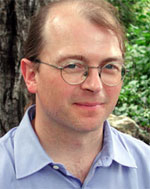
SETH LLOYD
I arrived in Monterey that evening tired and sweaty: my route there from Japan had included climbing a mountain in LA that morning and I hadn't had time to change.
JB immediately tossed me in a corner of the restaurant with Sergey Brin and Larry Page, who grilled me on the potential applications of quantum computation. They were shockingly knowledgeable on the subject and quickly pushed me like a novice sumo wrestler to edge of the ring that marks the boundary between the known and the unknown. That boundary is always closer than one thinks.
We agreed that quantum internet searches are a few years off. I had spent the afternoon in Jeff Kimble's lab at Caltech contemplating the first node of the the quantum internet — a single atom trapped in an optical cavity, capable of exchanging entangled photons with any other nodes, as soon as they are brought into existence. But when the quantum internet has only one node, containing one bit, Q-Google (Quoogle?) is not yet necessary. Sergey and Larry and I noted that when it is up and running, the quantum internet should offer all sorts of wacky possibilities for quantum internet search. Searches could be made significantly more efficient, for example, by using quantum parallelism to explore every node of the quantum internet simultaneously. Problems arise, however, from the fact that quantum bits can't be cloned. I cannot go further into our discussion as that would involve proprietary information concerning quantum internet protocols (e.g., Q-TCPIP).
Sergey broached the subject of massive entanglement and decoherence, a hot topic in quantum information these days (Entanglement is a peculiarly quantum-mechanical effect in which a bunch of quantum systems such as atoms share more information with each other than is possible classically. Entanglement is the branch of quantum weirdness that allows quantum computers to function. Decoherence is a process that destroys entanglement. As I said, these guys were really on top of their quanta).
We discussed recent experiments that Dave Cory and I had done at MIT, and Sergey made a rather fine suggestion for an experiment to test whether gagillions of entangled nuclear spins decohere faster than gagillions of unentangled nuclear spins. Dave and I will check it out.
At this point Jeffrey Epstein joined the conversation and demanded to know whether weird quantum effects had played a significant role in the origins of life. That question pushed me way out of the sumo ring into the deep unknown. We tried to construct a version of the question that could be answered. I was pushing my own personal theory of everything (the universe is a giant quantum computer, and to understand how things like life came into existence, we have to understand how atoms, molecules, and photons process information). Jeffrey was pushing back with his own theory (we need to understand what problem was being solved at the moment life came into being). By pushing from both sides, we managed to assemble a metaphor in which molecules divert the flow of free energy to their own recreational purposes (i.e., literally recreating themselves) somewhat in the way Jeffrey manages to divert the flow of money as it moves from time-zone to time-zone, using that money for his own recreational purposes (i.e., to create more money). I'm not saying it was the right way to describe the origins of life: I'm just saying that it was fun.
SETH LLOYD is Professor of Quantum-Mechanical Engineering, MIT.
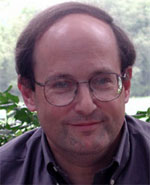
PAUL STEINHARDT
Three of the people I spoke with at the Dinner were Alisa Volkman from Nerve, Steve Petranek of Discover, and Jeff Bezos from Amazon. Alisa and I spoke about the cosmos and film, and creativity in our respective work. Jeff is a Princeton graduate who spent his first three years as a physics major. We talked about physics and engineering at Princeton and the challenge of mentoring young people and helping them excel. Steve Petranek and I talked about dark matter, dark energy and gravity.
PAUL STEINHARDT, father of "The Cyclic Theory of the Universe" is the Albert Einstein Professor in Science and on the faculty of both the Departments of Physics and Astrophysical Sciences at Princeton University.

LINDA STONE
I sat next to Jackie Bezos and Tom Reilly and across from Jeff Bezos and Kevin Kelly. The laughter was so loud, so continuous and so infectious that the conversation gently threaded it's way through the laughter. We talked about Asia, physics and space, outsourcing to India and China, and a whole lot of other thngs that gave us endless pleasure.
It was a magical evening.
LINDA STONE is a former Apple and Microsoft executive.
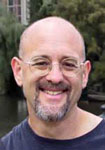
DANIEL GILBERT
I had the pleasure of being seated at the end of a long table and across from Lenny Susskind, so everyone else was pretty much outside my sonic reach. Lenny told me a bit about physics, I told him a bit about psychology, and then we spent the rest of the evening talking about the many odd coincidences in our personal histories. We both had checkered pasts that included more than a little aimlessness, delinquency, truancy, bad grades, and youthful marriages. No one would have bet that we'd ever go to college, much less become professors. Indeed, Lenny and I had so much in common that the only way the waiter could tell us apart was that Lenny invented string theory and I didn't. Good thing I held back on that one, otherwise there would have been some confusion about who got the chicken curry.
DANIEL GILBERT is Professor of Psychology at Harvard University.
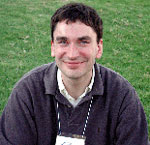
JEAN PAUL SCHMETZ
I sat at a table with Eva Wisten, Paul Steinhardt, Lenny Susskind, Dan Gilbert and Alisa Volkman. It was a wonderful dinner. I talked a lot about media with Eva Wisten (she's a journalist and we publish some 250 magazines). I also discovered that Lenny does not like religion at all (me neither, and I cannot remember how we got to talk about this). Later, I talked to Steven Strogatz and Stephen Petranek but I forgot what we talked about. I remember talking to my old friend Megan Smith for a long time about Space Camp which I plan to go to with my kids soon.
I feel very happy about having been to the dinner and at the same time a bit unhappy not having talked to more people (I guess Dan Gilbert is right about the twisted relationship between choice and happiness).
JEAN PAUL SCHMETZ is Managing Director of CyberLab Interactive Productions GmbH, a subsidiary of the Burda Media Group and a Member of the Executive Board of Burda New Media GmbH.
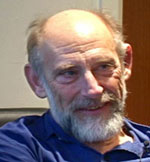
LEONARD SUSSKIND
Larry Page who told me about his experiences taking a physics course from me. The psychologist Daniel Gilbert . We talked a lot about life, love and the pursuit of the ladies. I explained physics and cosmology to him and explained a lot of interesting psych phenomena to me. I loved it. The two young women, Eva and Alisa. We talked about you. I hope they remember more because I don't. But it was for sure the most interesting dinner company that I've had since the old days with my physicist friends Sidney Coleman, Dick Feynman and Jack Goldberg. It could become addictive.
LEONARD SUSSKIND, the father of string theory, is Felix Bloch Professor in theoretical physics at Stanford University.
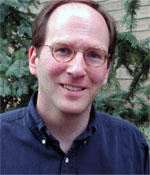
STEVEN STROGATZ
Steve Petranek, the editor of Discover magazine, was sitting on my right. Rodney Brooks, the MIT artificial intelligence researcher who makes little insect-like robots, was on my left. Both are fun and easy to be around. I always like to hear people's life stories, and without too much effort, I managed to get both of them to tell how they got to where they are today. Pertranek told of his days as a cub reporter at various small newspapers, covering all sorts of different areas, from finance to energy (where he did some investigative reporting and once broke a story about some shenanigans at a nuclear power plant, if I remember right). Brooks told charming stories of his days as a kid in Australia, playing out in his shed in the backyard, trying to build computers and other contraptions from spare parts and assorted junk, and nearly electrocuting himself or blowing himself up from time to time. It made me think about the importance of tinkering and fooling around.
It was a real treat—a night to cherish.
STEVEN STROGATZ is an applied mathematician at Cornell University and the author of Sync: The Emerging Science of Spontaneous Order.
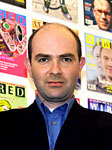
CHRIS W. ANDERSON
After reading of the quantum depths to which Sergey and Larry took Seth, I'm ashamed to recount that I spent most of my dinner asking Alan Guth beginner's questions about quantum communications. He patiently explained the pros and cons of electron vs. photon methods, and the difference between truly encrypted communications and those that simply reveal if they've been tapped by a third party.
Given that this isn't even his field, it was a virtuoso performance of clarity and deduction from first principles. Even better, he then followed up a day or two later with this email:
As I was leaving Monterey I met Robert Gelfond, the CEO of MagicQ Technologies Inc., which is in the business of quantum encryption.
It turned out that almost all of my guesses were right. The currently working systems are not what I would call a true quantum encryption device, which disguises each bit by flipping it or not flipping it according to the spin of an entangled particle. Instead they are quantum intruder-detection devices, which send photons on a light tube. The signal is mixed with a stream of photons with a predetermined pattern of polarizations, which are then verified at the other end. Since an intruder cannot measure the polarization of a single photon, he cannot detect photons and retransmit them in an identical polarization state. I think Robert said that they can send photons up to 50 km with complete security, and up to about 100 km with security that is safe as long as the intruder is limited to present technology. If one wants to go further, one must send the signal in steps of this length, with a secure box at each step which receives the message and retransmits it. There is no quantum algorithm that can detect an intruder who breaks open this box, so it must be secured by ordinary means.
The one point that I didn't foresee is that apparently it is not practical to send all bits by this method. Instead they use the protected photon signal only to distribute frequently changing encryption keys. Then the signal is transmitted separately, using ordinary transmission lines and ordinary encryption, such as perhaps DES. As long as the key is changed frequently, this is regarded as safe.
Most rewarding dinner conversation I've had for ages!
CHRIS W. ANDERSON is Editor-in-Chief of Wired.
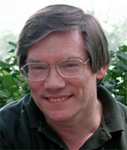
ALAN GUTH, father in the inflationary theory of the Universe, is Victor F. Weisskopf Professor of Physics at MIT; author of The Inflationary Universe.
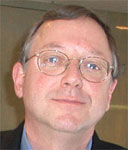
STEVE PETRANEK
I sat next to Steve Strogatz, the Cornell mathematician who wrote one of my favorite books, Sync. He was to my left. To my right was the lyrical, mystical and charming Ariane de Bonvoisin. I sat across from Nancy Etcoff, the research psychologist from Harvard Medical School who has actually defined the word happiness in such depth that it continues to astound me. I kept trying to get some free shrinking from Nancy but she effortlessly shifted the subject of my childhood back to her present research, which was nearly as fascinating.??When others swept Nancy's attention away I turned to Ariane, who unfortunately knows how to work a room full of smart people and kept disappearing. However, I learned enough about her project to publish books that get people through the first 30 days of a crisis (divorce, death of a spouse, realization there isn't a Santa Claus) to know that I'd probably buy each and every one of them even if the crisis didn't match my circumstances (One always has friends in crisis).
Strogatz pulled a reversal by interviewing me before I got to interview him. His descriptions of fireflies along riverbanks syncing up their flashes was far more mesmerizing in person (and after a couple glasses of wine) than it is in the book. Of course, I did my best to stay as far away from Dan Dubno as I could, which turned out to be fairly easy because he was toadying up to Steve Case all night.
As the soiree ended, physicist Paul Stenhardt asked me a few pointed questions about my definition of gravity as I had referred to it in my TED presentation. Besides being embarrassed by my inability to be as clear as a cosmologist can be on what holds us down to this planet, I was fascinated to be led by him to the idea that gravity might be quite different on at least four planes: gravity in very large circumstances, like everything in the universe flying away from everything else at an accelerated pace; gravity on the scale I'm used to as I move across the Earth; gravity in very tiny (quantum) circumstances; and gravity under intense pressure and heat circumstances. All of which made me sorry that dinner came to an end.
STEVE PETRANEK is editor in chief of Discover.
Attendees: Pam Alexander, Alexander Ogilvy; Chris Anderson, TED; Chris Anderson, Wired; Jeff Bezos, amazon.com; Jackie Bezos, amazon.com; Adam Bly, Seed; Stewart Brand, Long Now Foundation; Sergey Brin, Google; Patti Brown, New York Times; Steve Case; Mihalyi Csikszentmihalyi, Claremont; Steffi Czerny, Burda Media; Susan Dawson, Sapling Foundation; Ariane De Bonvoisin; Dan Dubno, CBS News; Jeffrey Epstein, Epstein Assoc.; Nancy Etcoff, Harvard Medical School; Daniel Gilbert, Harvard; Alan Guth, MIT; Katrina Heron; Kevin Kelly, Wired; Seth Lloyd. MIT; Pam Omidyar, Omidyar Foundation; Pierre Omidyar, eBay ; Larry Page, Google; Steve Petranek,Discover; Ryan Phelan, DNA Direct; Tom Rielly, TED; Forrest Sawyer, MSNBC; Eric Schmidt, Google; Martin Seligman, UPenn; Megan Smith, Google; Paul Steinhardt, Princeton; Cyndi Stivers, Time Out New York ; Linda Stone; Steven Strogatz, Cornell; Leonard Susskind, Stanford; Kara Swisher, Wall Street Journal; Yossi Vardi, ICQ; Alisa Volkman, Nerve; Eva Wisten, Bon Magazine; Michael Wolff, Vanity Fair
The metaphors of information processing and computation are at the center of today's intellectual action. A new and unified language of science is beginning to emerge.

Participants:
 |
 |
 |
 |
 |
| Seth Lloyd | Paul Steinhardt | Alan Guth | Marvin Minsky | Ray Kurzweil |
| Computational Universe | Cyclic Universe | Inflationary Universe | Emotion Universe | Intelligent Universe |
What's happening in these new scientific endeavors is truly a work in progress. A year ago, at the first REBOOTING CIVILIZATION meeting in July, 2001, physicists Alan Guth and Brian Greene, computer scientists David Gelernter, Jaron Lanier, and Jordan Pollack, and research psychologist Marc D. Hauser could not reach a consensus about exactly what computation is, when it is useful, when it is inappropriate, and what it reveals. Reporting on the event in The New York Times ("Time of Growing Pains for Information Age", August 7, 2001), Dennis Overbye wrote:On July 21, Edge held an event at Eastover Farm which included the physicists Seth Lloyd, Paul Steinhardt, and Alan Guth, computer scientist Marvin Minsky, and technologist Ray Kurzweil. This year, I noted there are a lot of "universes" floating around. Seth Lloyd: the computational universe (or, if you prefer, the it and bit-itty bitty-universe); Paul Steinhardt: the cyclic universe; Alan Guth: the inflationary universe; Marvin Minsky: the emotion universe, Ray Kurzweil: the intelligent universe. I asked each of the speakers to comment on their "universe". All, to some degree, were concerned with information processing and computation as central metaphors. See below for their links to their talks and streaming video.??Concepts of information and computation have infiltrated a wide range of sciences, from physics and cosmology, to cognitive psychology, to evolutionary biology, to genetic engineering. Such innovations as the binary code, the bit, and the algorithm have been applied in ways that reach far beyond the programming of computers, and are being used to understand such mysteries as the origins of the universe, the operation of the human body, and the working of the mind. ?
Mr. Brockman said he had been inspired to gather the group by a conversation with Dr. Seth Lloyd, a professor of mechanical engineering and quantum computing expert at M.I.T. Mr. Brockman recently posted Dr. Lloyd's statement on his Web site, www.edge.org: "Of course, one way of thinking about all of life and civilization," Dr. Lloyd said, "is as being about how the world registers and processes information. Certainly that's what sex is about; that's what history is about.
Humans have always tended to try to envision the world and themselves in terms of the latest technology. In the 17th and 18th centuries, for example, workings of the cosmos were thought of as the workings of a clock, and the building of clockwork automata was fashionable. But not everybody in the world of computers and science agrees with Dr. Lloyd that the computation metaphor is ready for prime time.
Several of the people gathered under the maple tree had come in the hopes of debating that issue with Dr. Lloyd, but he could not attend at the last moment. Others were drawn by what Dr. Greene called "the glimmer of a unified language" in which to talk about physics, biology, neuroscience and other realms of thought. What happened instead was an illustration of how hard it is to define a revolution from the inside.
Indeed, exactly what computation and information are continue to be subjects of intense debate. But less than a year later, in the "Week In Review" section of the Sunday New York Times ("What's So New In A Newfangled Science?", June 16, 2002) George Johnson wrote about "a movement some call digital physics or digital philosophy — a worldview that has been slowly developing for 20 years."...
Just last week, a professor at the Massachusetts Institute of Technology named Seth Lloyd published a paper in Physical Review Letters estimating how many calculations the universe could have performed since the Big Bang — 10^120 operations on 10^90 bits of data, putting the mightiest supercomputer to shame. This grand computation essentially consists of subatomic particles ricocheting off one another and "calculating" where to go.
As the researcher Tommaso Toffoli mused back in 1984, "In a sense, nature has been continually computing the `next state' of the universe for billions of years; all we have to do — and, actually, all we can do — is `hitch a ride' on this huge ongoing computation."
This may seem like an odd way to think about cosmology. But some scientists find it no weirder than imagining that particles dutifully obey ethereal equations expressing the laws of physics. Last year Dr. Lloyd created a stir on Edge.org, a Web site devoted to discussions of cutting edge science, when he proposed "Lloyd's hypothesis": "Everything that's worth understanding about a complex system can be understood in terms of how it processes information."*....
[*See "Seth Lloyd: How Fast, How Small, and How Powerful: Moore's Law and the Ultimate Laptop"]
Dr, Lloyd did indeed cause a stir when his ideas were presented on Edge in 2001, but George Johnson's recent New York Times piece caused an even greater stir, as Edge received over half a million unique visits the following week, a strong confirmation that something is indeed happening here. (Usual Edge readership is about 60,000 unique visitors a month). There is no longer any doubt that the metaphors of information processing and computation are at the center of today's intellectual action. A new and unified language of science is beginning to emerge.
THE COMPUTATIONAL UNIVERSE:SETH LLOYD [9.19.02]
Every physical system registers information, and just by evolving in time, by doing its thing, it changes that information, transforms that information, or, if you like, processes that information. Since I've been building quantum computers I've come around to thinking about the world in terms of how it processes information.
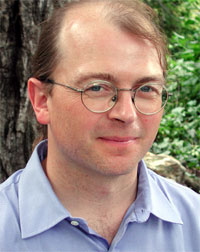
SETH LLOYD is Professor of Mechanical Engineering at MIT and a principal investigator at the Research Laboratory of Electronics. He is also adjunct assistant professor at the Santa Fe Institute. He works on problems having to do with information and complex systems from the very small—how do atoms process information, how can you make them compute, to the very large — how does society process information? And how can we understand society in terms of its ability to process information?
His seminal work in the fields of quantum computation and quantum communications — including proposing the first technologically feasible design for a quantum computer, demonstrating the viability of quantum analog computation, proving quantum analogs of Shannon's noisy channel theorem, and designing novel methods for quantum error correction and noise reduction — has gained him a reputation as an innovator and leader in the field of quantum computing. Lloyd has been featured widely in the mainstream media including the front page of The New York Times, The LA Times, The Washington Post, The Economist, Wired, The Dallas Morning News, and The Times (London), among others. His name also frequently appears (both as writer and subject) in the pages of Nature, New Scientist, Science and Scientific American.
THE CYCLIC UNIVERSE: PAUL STEINHARDT [9.16.02]

...in the last year I've been involved in the development of an alternative theory that turns the cosmic history topsy-turvy. All the events that created the important features of our universe occur in a different order, by different physics, at different times, over different time scales—and yet this model seems capable of reproducing all of the successful predictions of the consensus picture with the same exquisite detail.
THE INFLATIONARY UNIVERSE:ALAN GUTH [9.16.02]
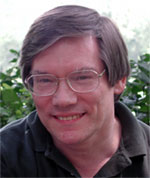
Inflationary theory itself is a twist on the conventional Big Bang theory. The shortcoming that inflation is intended to fill in is the basic fact that although the Big Bang theory is called the Big Bang theory it is, in fact, not really a theory of a bang at all; it never was.
THE EMOTION UNIVERSE: MARVIN MINSKY [9.16.02]
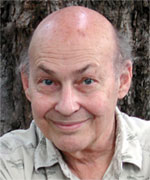
To say that the universe exists is silly, because it's saying that the universe is one of the things in the universe. There's something wrong with that idea. If you carry that a little further, then it doesn't make any sense to have a predicate like, "Where did the universe come from?" or "Why does it exist?"
THE INTELLIGENT UNIVERSE: RAY KURZWEIL [9.16.02]
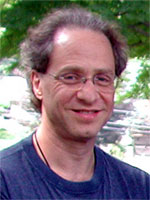
The universe has been set up in an exquisitely specific way so that evolution could produce the people that are sitting here today and we could use our intelligence to talk about the universe. We see a formidable power in the ability to use our minds and the tools we've created to gather evidence, to use our inferential abilities to develop theories, to test the theories, and to understand the universe at increasingly precise levels.

WHICH UNIVERSE WOULD YOU LIKE?
Five stars of American science meet in Connecticut to explain first and last things.
August 28, 2002
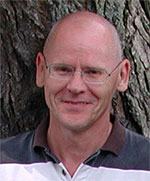
They begin a free-floating debate, which drives them back and forth across the universe. Guth encourages the exploration of black holes, not to be confused with cosmic wormholes, which Kurzweil — just like the heroes of Star Trek — wants to use as a shortcut for his intergalactic excursions and as a means of overtaking light. Steinhardt suggests that we should realize that we are not familiar with most of what the cosmos consists of and do not understand its greatest force, dark matter. Understand? There is no such thing as a rational process, Minsky objects; it is simply a myth. In his cosmos, emotion is a word we use to circumscribe another form of our thinking that we cannot yet conceive of. Emotion, Kurzweil interrupts, is a highly intelligent form of thinking. "We have a dinner reservation at a nearby country restaurant," says Brockman in an emotionally neutral tone.

This media life
My Dinner with Rupert
How do you get the king of all media to break bread with you when — truth be told — you've often said unkind things about him? Michael Wolff on his precious moments with the gossipy mogul.
By Michael Wolff
In an unlikely turn of events — and thanks to some shameless maneuvering to achieve (and protect) proximity — our Murdoch-deconstructing media columnist breaks bread with the man himself.
Rupert kept talking. He grew more expansive, more conspiratorial, even (although it did seem like he'd conspire with anyone), his commentary more intimate. We proposed that he come with us to the dinner we were scheduled to go to — John Brockman's Billionaire's dinner, a TED ritual......
![]()
"The TED Conference: 3 Days in the Future"
By Patricia Leigh Brown
February 28, 2002
(free registration required)
MONTEREY, Calif., Feb. 23 — What preternatural power can prompt Rupert Murdoch, Jeffrey Katzenberg, Richard Dawkins, Neil Simon, Art Buchwald, Frank Gehry and Quincy Jones to sit for hours in a hot room contemplating the nano-sized split ends on gecko toes? ...
...Where else but at TED would Mr. Katzenberg, standing Armani-deep in sawdust with Spirit, his stallion and the namesake of his new animated film, be upstaged by Rex, a biologically inspired robot with springy legs and gecko-like feet capable of navigating the outer reaches of the Amazon — specifically, the leg of the Amazon.com founder, Jeff Bezos, a longtime Tedster?
It can get deep. Very deep. Steven Pinker, the eminent cognitive psychologist, found himself deep in conversation with the singer Naomi Judd about the role of the amygdala, the part of the brain that colors memory with emotion; something, he aptly noted, "that would not happen at the meeting of the Cognitive Neuroscience Society."
It happened here one night last week over chicken and polenta at the annual private dinner, given by the New York literary agent John Brockman, formerly called the Millionaires' and Billionaires' Dinner after the rich techies who traditionally flocked to TED. There were still a few members of that endangered species scattered about, among them Nathan Myhrvold, the retired Microsoft chief technology officer, who gave an electrifying discourse at the 1997 TED about dinosaur sex. .....
Everything is up for grabs. Everything will change. There is a magnificent sweep of intellectual landscape right in front of us.

One aspect of our culture that is no longer open to question is that the most signigicant developments in the sciences today (i.e. those that affect the lives of everybody on the planet) are about, informed by, or implemented through advances in software and computation. This Edgeevent presented an opportunity for people in the various fields of computer science, cosmology, cognition, evolutionary biology, etc., to begin talking to each other, to become aware of interesting and important work in other fields.
Participants:
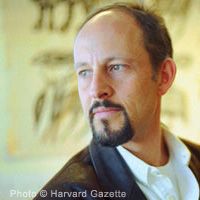 |
 |
 |
 |
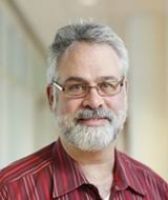 |
 |
 |
| Marc D. Hauser | Lee Smolin | Brain Greene | Jaron Lanier | Jordan Pollack | David Gelernter | Alan Guth |
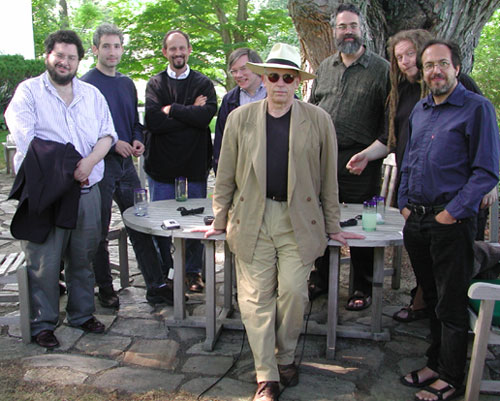
HAUSER, SMOLIN, GREENE, LANIER, POLLACK, GELERNTER, GUTH at the Edge "REBOOTING CIVILIZATION" meeting at Eastover Farm. Opening comments [12,000 words] and streaming video.
Software and computation are reinventing the civilized world —"rebooting civilization," in the words of David Gelernter. "It's a software-first world," notes Stanford AI expert Edward Feigenbaum, chief scientist of the U.S. Air Force in the mid-nineties. "It's not a mistake that the world's two richest men are pure software plays. Or that the most advanced fighter planes in the U.S. Air Force are bundles of software wrapped in aluminum shells, or that the most advanced bomber is run by computers and cannot be flown manually". Everybody in business today is in the software business. But what comes after software?
Experimental psychologist Steven Pinker speaks of "a new understanding that the human mind is a remarkably complex processor of information." To Pinker, our minds are "organs of computation." To philosopher Daniel C. Dennett, "the basic idea of computation, as formulated by the mathematicians John von Neumann and Alan Turing, is in a class by itself as a breakthrough idea." Dennett asks us to think about the idea that what we have in our heads is software, "a virtual machine, in the same way that a word processor is a virtual machine." Pinker and Dennett are talking about our mental life in terms of the idea of computation, not simply proposing the digital computer as a metaphor for the mind. Other scientists such as physicist Freeman Dyson disagree , but most recognize that these are big questions.??Physicist David Deutsch, a pioneer in the development of the quantum computer, points out that "the chances are that the technological implications of quantum computers, though large by some standards, are never going to be the really important thing about them. The really important thing is the philosophical implications, epistemological and metaphysical. The largest implication, from my point of view, is the one that we get right from the beginning, even before we build the first quantum computer, before we build the first cubit. The very theory of quantum computers already forces upon us a view of physical reality as a multiverse."??Computer scientist and AI researcher Rodney Brooks is puzzled that "we've got all these biological metaphors that we're playing around with — artificial immunology systems, building robots that appear lifelike — but none of them come close to real biological systems in robustness and in performance. They look a little like it, but they're not really like biological systems." Brooks worries that in looking at biological systems we are missing something that is already there — that has always been there. To Brooks, this might be called "the essence of life," but he is talking about a biochemical phenomenon, not a metaphysical one. Brooks is searching for a new conceptual framework that, like computation, does not involve any new physics or chemistry — a framework that gives us a different way of thinking about the stuff that's there. "We see the biological systems, we see how they operate," he says, "but we don't have the right explanatory modes to explain what's going on and therefore we can't reproduce all these sorts of biological processes. That to me right now is the deep question."
One aspect of our culture that is no longer open to question is that the most signigicant developments in the sciences today (i.e. the developments that affect the lives of everybody on the planet) are about, informed by, or implemented through advances in software and computation.
This Edge event is an opportunity for people in various fields such as computer science, cosmology, cognition, evolutionary biology, etc., to begin talking to each other, to become aware of interesting and important work in other fields.
— JB
Some of the problems that we've been dealing with in the neurosciences and the cognitive sciences concerns the initial state of the organism. What do animals, including humans, come equipped with? What are the tools that they have to deal with the world as it is? There's somewhat of an illusion in the neurosciences that we have really begun to understand how the brain works. That's put quite nicely in a recent talk by Noam Chomsky. The title of the talk was "Language and the Brain."
Everybody's very surprised to hear him mention the brain word, since he's mostly referred to the mind. The talk was a warning to the neuroscientists about how little we know about, especially when it comes to understanding how the brain actually does language. Here's the idea Chomsky played with, which I think is quite right. Let's take a very simple system that is actually very good at a kind of computation: the honey bee. Here is this very little insect, tiny little brain, simple nervous system, that is capable of transmitting information about where it's been and what it's eaten to a colony and that information is sufficiently precise that the colony members can go find the food. We know that that kind of information is encoded in the signal because people in Denmark have created a robotic honey bee that you can plop in the middle of a colony, programmed to dance in a certain way, and the hive members will actually follow the information precisely to that location. Researchers have been able to understand the information processing system to this level, and consequently, can actually transmit it through the robot to other members of the hive. When you step back and say, what do we know about how the brain of a honeybee represents that information, the answer is: we know nothing. Thus, our understanding of the way in which a bee's brain represents its dance, its language, is quite poor. And this lack of understanding comes from the study of a relatively simple nervous system, especially when contrasted with the human nervous system.
So the point that Chomsky made, which I think is a very powerful one, and not that well understood, is that what we actually know about how the human brain represents language is at some level very trivial. That's not to say that neuroscientists haven't made quite a lot of impact on, for example, what areas of the brain when damaged will wipe out language. For example, we know that you can find patients who have damage to a particular part of the brain that results in the loss of representations for consonants, while other patients have damage that results in the loss of representations for vowels.
But we know relatively little about how the circuitry of the brain represents the consonants and vowels. The chasm between the neurosciences today and understanding representations like language is very wide. It's a delusion that we are going to get close to that any time soon. We've gotten almost nowhere in how the bee's brain represents the simplicity of the dance language. Although any good biologist, after several hours of observation, can predict accurately where the bee is going, we currently have no understanding of how the brain actually performs that computation.
The reason there have been some advances in the computational domain is there's been a lot of systems where the behavior showcases what the problem truly is, ranging from echolocation in bats to long distance navigation in birds. For humans, Chomsky's insights into the computational mechanisms underlying language really revolutionized the field, even though not all would agree with the approach he has taken. Nonetheless, the fact that he pointed to the universality of many linguistic features, and the poverty of the input for the child acquiring language, suggested that an innate computational mechanism must be at play. This insight revolutionized the field of linguistics, and set much of the cognitive sciences in motion. That's a verbal claim, and as Chomsky himself would quickly recognize, we really don't know how the brain generates such computation.
One of the interesting things about evolution that's been telling us more and more is that even though evolution has no direction, one of the things you can see, for example, within the primates is that a part of the brain that actually stores the information for a representation, the frontal lobes of our brain, has undergone quite a massive change over time. So you have systems like the apes who probably don't have the neural structures that would allow them to do the kind of computations you need to do language-processing. In our own work we've begun to look at the kinds of computations that animals are capable of, as well as the kind of computations that human infants are capable of, to try to see where the constraints lie.
Whenever nature has created systems that seem to be open-ended and generative, they've used some kind of system with a discrete set of recombinable elements. The question you can begin to ask in biology is, what kind of systems are capable of those kinds of computational processes. For example, many organisms seem to be capable of quite simple statistical computations, such as conditional probabilities that focus on local dependencies: if A, then B. Lots of animals seem capable of that. But when you step up to the next level in the computational hierarchy, one that requires recursion, you find great limitations both among animals and human infants. For example, an animal that can do if A then B, would have great difficulty doing if A to the N, then B to the N. We now begin to have a loop. If animals lack this capacity, which we believe is true, then we have identified an evolutionary constraint; humans seem to have evolved the capacity for recursion, a computation that liberated us in an incredible way.
It allows us to do mathematics as well as language. And this system of taking discrete or particulate elements and recombining them, is what gives genetics and chemistry their open ended structure. Given this pattern, an interesting question then is: what were the selective pressures that led to the evolution of a recursive system? Why is it that humans seem to be the only organisms on the planet, the only natural system, that has this capacity? What were the pressures that created it? Thinking about things like artificial intelligence, what would be the kinds of pressures on an artificial system that would get to that end point?
An interesting problem for natural biological systems as well as artificial systems is whether the two can meet, to try to figure out what kinds of pressures lead to a capacity for recursion, what are the building blocks that must be in place for the system to evolve? Comparative biology doesn't provide any helpful hints at present because we simply have two end points, humans that do it, and other organisms that don't. At this point in time, therefore, this evolutionary transition is opaque.
MARC D. HAUSER, a cognitive neuroscientist, is a professor in the departments of Psychology and the Program in Neurosciences at Harvard, where he is also a fellow of the Mind, Brain, and Behavior Program. He is the author of The Evolution of Communication, The Design of Animal Communication (with M. Konishi), and Wild Minds: What Animals Really Think.
As a theoretical physicist, my main concern is space, time and cosmology. The metaphor about information and computation is interesting. There are some people in physics who have begun to talk as if we all know that what's really behind physics is computation and information, who find it very natural to say things like anything that's happening in the world is a computation, and all of physics can be understood in terms of information. There's another set of physicists who have no idea what those people are talking about. And there's a third set — and I'm among them — who begin by saying we have no idea what you're talking about, but we have reasons why it would be nice if it was useful to talk about physics in terms of information.
I can mention two ways in which the metaphor of information and computation may be infiltrating into our thinking about fundamental physics, although we're a long way from really understanding these things. The first is that the mathematical metaphor and the conceptual metaphor of a system of relationships which evolves in time is something which is found in physics. It is also something that we clearly see when we talk to computer scientists and biologists and people who work on evolutionary theory, that they tend to model their systems in terms of networks where there are nodes and there are relationships between the nodes, and those things evolve in time, and they can be asking questions about the time evolution, what happens after a long time, what are the statistical properties of subsystems.
That kind of idea came into physics a long time ago with relativity theory and general relativity. The idea that all the properties of interest are really about relationships between things and not a relationship between some thing and some absolute fixed background that defines what anything means is an important idea and an old idea in physics. In classical general relativity, one sees the realization of the idea that all the properties that we observe are about relationships. Those of us who are interested in quantum gravity are thinking a lot about how to bring that picture, in which the world is an evolving network of relationships, into quantum physics.
And there are several different aspects of that. There are very interesting ideas around but they're in the stage of interesting ideas, interesting models, interesting attempts — it is science in progress.
That's the first thing. To the extent to which our physics will turn out to look like a network of relationships which are evolving in time, physics will look like some system that computational people or biologists using the computational metaphor may be studying. Part of that is the questions of whether nature is really discrete — that underlying the continuous notion of space and time there's really some discrete structure, that's also something that from different points of view — when we work on quantum gravity we find evidence that space and time are really discrete and are really made up on processes which may have some discrete character. But again, this is something in progress.
One piece of evidence that nature is discrete is something called the holographic principle. This leads some of us physicists to use the word information even when we don't really know what we're talking about but it is interesting and worth exposing. It comes from an idea called the Bekenstein Bound, a conjecture of Jacob Bekenstein that there is more and more theoretical evidence for. The Bekenstein Bound says that if I have a surface and I'm making observations on that surface —that surface could be my retina, or it could be some screen in front of me — I observe the world through the screen, at any one moment there's a limitation to the amount of information that could be observed on that screen.
First of all that amount of information is finite, and it's four bits of information per Planck area of the screen, where a Planck area is 10 to the minus 66 centimeters squared. And there are various arguments that if that bound were to be exceeded, in a world where there is relativity and black holes, then we would violate the Second Law of Thermodynamics. Since none of us wants to violate the Second Law of Thermodynamics, I think it's an important clue, and it says something important about the underlying discreteness of nature. It also suggests that information, although we don't know what information is, may have some fundamental place in physics.
The holographic principle, of which there are several versions by different people — the idea was invented by Dutch theoretical physicist Gerard 't Hooft — is that the laws of physics should be rewritten, or could be rewritten including dynamics, how things evolve in time, so we're no longer talking about things happening out there in the world in space, we're talking about representing systems that we observe in terms of the information as it evolves on the screen. The metaphor is that there's a screen through which we're observing the world. There are various claims that this idea is realized at least partly in several different versions of string theory or quantum gravity This is an idea there's a lot of interest in, but we really don't know whether it can be realized completely or not.
One extreme form of it, which I like, is that perhaps the way to read the Bekenstein Bound is not that there are two different things, geometry and flow of information and a law that relates them, but somehow we could try to envision the world as one of these evolving networks. What happens is processes where "information", whatever information is, flows from event to event, and geometry is defined by saying that the measure of the information capacity of some channel by which information is flowing, from the past to the future, would be the area of a surface, so that somehow geometry that is space would turn out to be some derived quantity, like temperature or density, and just the same way that temperature is a measure of the average energy of some particles, the area of some surface would turn out to be an approximate measure of the capacity of some channel in the world would fundamentally be information flow. It's an idea that some of us like to play with, but we have not yet constructed physics on those grounds, and it's not at all clear that it will work. This is a transition to a computational metaphor in physics — it's something which is in progress, and may or may not happen.
LEE SMOLIN, a theoretical physicist, is a founding member and research physicist at the Perimeter Institute in Waterloo Canada. He is the author ofThe Life of The Cosmos and Three Roads to Quantum Gravity.
Physics and everything we know in the world around us may really be tied to processes whose fundamental existence is not here around us, but rather exists in some distant bounding surface like some thin hologram, which by virtue of illuminating it in the right way can reproduce what looks like a 3-dimensional world. Perhaps our three dimensional world is really just a holographic illumination of laws that exist on some thin bounding slice, like that thin little piece of plastic, that thin hologram. It's an amazing idea, and I think is likely to be where physics goes in the next few years or in the next decade, at least when one's talking about quantum gravity or quantum string theory.
[Opening comments to come.]
BRIAN GREENE, professor of physics and of mathematics, at Columbia University is widely regarded for a number of groundbreaking discoveries in superstring theory. He is the author of The Elegant Universe: Superstrings, Hidden Dimensions, and the Quest for an Ultimate Theory.
One of the striking things about being a computer scientist in this age is that all sorts of other people are happy to tell us that what we do is the central metaphor of everything, which is very ego-gratifying. We hear from various quarters that our work can serve as the best way of understanding - if not in the present but any minute now because of Moore's law - of everything from biology to the economy to aesthetics, child-rearing, sex, you name it. I have found myself being critical of what I view as this overuse as the computational metaphor. My initial motivation was because I thought there was naive and poorly constructed philosophy at work. It's as if these people had never read philosophy at all and there was no sense of epistemological or other problems.
Then I became concerned for a different reason which was pragmatic and immediate: I became convinced that the overuse of the computational metaphor was actually harming the quality of the present-day design of computer systems. One example of that, the belief that people and computers are similar, the artificial intelligence mindset, has a tendency to create systems that are naively and overly automated. An example of that is the Microsoft word processor that attempts to retype what you've just typed, the notion of trying to make computers into people because somehow that agenda of making them into people is so important that if you jump the gun it has to be for the greater good, even if it makes the current software stupid.
There's a third reason to be suspicious of the overuse of computer metaphors, and that is that it leads us by reflection to have an overly simplistic view of computers. The particular simplification of computers I'm concerned with is imagining that Moore's Law applies to software as well as hardware. More specifically, that Moore's Law applies to things that have to have complicated interfaces with their surroundings as opposed to things that have simple interfaces with their surroundings, which I think is the better distinction.
Moore's Law is truly an overwhelming phenomenon; it represents the greatest triumph of technology ever, the fact that we could keep on this track that was predicted for all these many years and that we have machines that are a million times better than they were at the dawn of our work, which was just a half century ago. And yet during that same period of time our software has really not kept pace. In fact not only could you argue that software has not improved at the same rate as hardware, you could even argue that it's often been in retrograde. It seems to me that our software architectures have not even been able to maintain their initial functionality as they've scaled with hardware, so that in effect we've had worse and worse software. Most people who use personal computers can experience that effect directly, and it's true in most situations.
But I want to emphasize that the real distinction that I see is between systems with simple interfaces to their surroundings and systems with complex interfaces. If you want to have a fancy user interface and you run a bigger thing it just gets awful. Windows doesn't scale.
One question to ask is, why does software suck so badly? There are a number of answers to that. The first thing I would say is that I have absolutely no doubt that David Gelernter's framework of streams is fundamentally and overwhelmingly superior to the basis in which our current software is designed. The next question is, is that enough to cause it to come about? It really becomes a competition between good taste and good judgment on the one hand, and legacy and corruption on the other - which are effectively two words for the same thing, in effect. What happens with software systems is that the legacy effects end up being the overwhelming determinants of what can happen next as the systems scale.
For instance, there is the idea of the computer file, which was debated up until the early 80s. There was an active contingent that thought that the idea of the file wasn't a good thing and we should instead have a massive distributed data base with a micro-structure of some sort. The first (unreleased) version of the Macintosh did not have files. But Unix jumped the fence from the academic to the business world and it had files, and Macintosh ultimately came out with files, and the Microsoft world had files, and basically everything has files. At this point, when we teach undergraduates computer science, we do not talk about the file as an invention, but speak of it as if it were a photon, because it in effect is more likely to still be around in 50 years than the photon.
I can imagine physicists coming up with some reasons not to believe in photons any more, but I cannot imagine any way that we can tell you not to believe in files. We are stuck with the damn things. That legacy effect is truly astonishing, the sort of non-linearity of the costs of undoing decisions that have been made. The remarkable degree to which the arrow of time is amplified in software development in its brutalness is extraordinary, and perhaps one of the things that really distinguishes software from other phenomena.
Back to the physics for a second. One of the most remarkable and startling insights in 20th century thought was Claude Shannon's connection of information and thermodynamics. Somehow for all of these years working with computers I've been looking at these things and I've been thinking, "Are these bits the same bits Shannon was talking about, or is there something different?" I still don't know the answer, but I'd like to share my recent thoughts because I think this all ties together. If you wish to treat the world as being computational and if you wish to say that the pair of sunglasses I am wearing is a computer that has sunglass input and output- if you wish to think of things that way, you would have to say that not all of the bits that are potentially measurable are in practice having an effect. Most of them are lost in statistical effects, and the situation has to be rather special for a particular bit to matter.
In fact, bits really do matter. If somebody says "I do" in the right context that means a lot, whereas a similar number of bits of information coming in another context might mean much less. Various measurable bits in the universe have vastly different potentials to have a causal impact. If you could possibly delineate all the bits you would probably see some dramatic power law where there would be a small number of bits that had tremendously greater potential for having an effect, and a vast number that had very small potentials. It's those bits that have the potential for great effect that are probably the ones that computer scientists are concerned with, and probably Shannon doesn't differentiate between those bits as far as he went.
Then the question is how do we distinguish between the bits; what differentiates one from the other, how can we talk about them? One speculation is that legacy effects have something to do with it. If you have a system with a vast configuration space, as is our world, and you have some process, perhaps an evolutionary process, that's searching through possible configurations, rather than just a meandering random walk, perhaps what we see in nature is a series of stair steps where legacies are created that prohibit large numbers of configurations from every being searched again, and that there's a series of refinements.
Once DNA has won out, variants of DNA are very unlikely to appear. Once Windows has appeared, it's stuck around, and so forth. Perhaps what happens is that the legacy effect, which is because of the non-linearity of the tremendous expense of reversing certain kinds of systems. Legacies that are created are like lenses that amplify certain bits to be more important. This suggests that legacies are similar to semantics on some fundamental level. And it suggests that the legacy effect might have something to do with the syntax/semantics distinction, to the degree that might be meaningful. And it's the first glimmer of a definition of semantics I've ever had, because I've always thought the word didn't mean a damn thing except "what we don't understand". But I'm beginning to think what it might be is the legacies that we're stuck with.
To tie the circle back to the "Rebooting Civilization" question, what I'm hoping might happen is as we start to gain a better understanding of how enormously difficult, slow, expensive, tedious and rare an event it is to program a very large computer well; as soon as we have a sense and appreciation of that, I think we can overcome the sort of intoxication that overcomes us when we think about Moore's Law, and start to apply computation metaphors more soberly to both natural science and to metaphorical purposes for society and so forth. A well-appreciated computer that included the difficulty of making large software well could serve as a far more beneficial metaphor than the cartoon computer, which is based only on Moore's Law; all you have to do is make it fast and everything will suddenly work, and the computers-will-become-smarter than-us-if-you just-wait-for-20-years sort of metaphor that has been prevalent lately.
The really good computer simulations that do exist in biology and in other areas of science, and I've been part of a few that count, particularly in surgical prediction and simulation, and in certain neuroscience simulations, have been enormously expensive. It took 18 years and 5,000 patients to get the first surgical simulation to the point of testable usability. That is what software is, that's what computers are, and we should de-intoxicate ourselves from Moore's Law before continuing with the use of this metaphor.
JARON LANIER, a computer scientist and musician, is best known for his work in virtual reality. He is the lead scientist for the National Tele-Immersion Initiative, a consortium of universities studying the implications and applications of next-generation Internet technologies.
The limits of software engineering have been clear now for about 20 years. We reached a limit in the size of the programs that we could build, and since then we've essentially just been putting them together in different packages and adding wallpaper. Windows is little more than just DOS with wallpaper - it doesn't really add any more fundamental complexity or autonomy to the process.
Being in AI, I see this "scale" of programming as the problem, not the speed of computers. Its not that we don't understand some principles, but we just can't write a program big enough. We have really big computers. You could hook up a Beowulf, you could hook up a Cray super computer to the smallest robot, and if you knew how to make the robot be alive, it would be alive, if all you needed was computer time. Moores law won't solve AI. Computer time is not what we need; we need to understand how to organize systems of biological complexity.
What I've been working with for the past decade or so has been this question of self-organization. How can a system of chemicals heated by the sun dissipate energy and become more and more complex over time? If we really understood that, we'd be able to build it into software, we'd be able to build it into electronics, and if we got the theory right, we would see a piece of software that ran and wasted energy in the form of computer cycles and became more and more complex over time, and perhaps would bust through the ten million line code limit. In this field, which I've been calling co-evolutionary learning, we have had limited successes in areas like games, problem-solving, and robotics, but no open ended self-organizing reaction. Yet.
It looks like biological complexity comes from the interplay of several different fields. Physics, Evolution, and Game theory. What's possible is determined by a set of rules. There are the immutable rules, systems that obey these rules, and create new systems which operate with rule-like behaviors that we think of as computation. Evolution enables a kind of exploration of the possible, putting together components in various ways, exploring a constrained space of possible designs. What was the fitness, what was the affordance, what was the reason that something arose? But that's only part of it. Physics (the rules) determine whats possible. Evolution (the variation) explores the possible. The Game determines what persists.
When we look at the results of our evolution and co-evolution software, we see that many early discoveries afford temporary advantages, but when something gets built on top of something, because it's part of a larger configuration, it persists, even tho it may be less optimal than other competitive discoveries.
I believe we're never going to get rid of the DOS file system, we're never going to get rid of the notepad text editor, we're never going to get rid of the Qwerty keyboard, because there are systems built on top of them. Just like the human eye has a blind spot.
At one point in human evolution there arose a bundle of nerves that twisted in the wrong direction and, even though it blocked a small bit of the visual field, nevertheless added some kind of advantage, and then layered systems built on top of that and locked the blind spot into being, and there's no way you can get rid of the blind spot now because it's essentially built in and supportive of other mechanisms.
We must look at the entire game to see what among the possible persists. Winners are not determined by the best technology, or by the best design. It's determined by a set of factors that says, whatever this thing is, it's part of a network, and that network supports its persistance. And as evolution proceeds, the suboptimal systems tend to stay in place. Just like vision has a blind spot, we're going to be stuck with technology upon which economic systems depend.
Studying more economics than a usual computer scientist, and reflecting back to the question of the change of society due to software, which John and I have called it the solvent - a social solvent - our naive notion of free enterprise, our naive notion of how competition works in economy is that there's supposed to be checks and balances. Supposedly a durable goods monopoly is impossible. To increase market share, the Tractor monopoly makes better tractors which sell more and last longer until the used market in perfectly good tractors at half the price stops them. As something gets bigger, as a company's products become more widely used, instead of locking into monopoly, there's supposed to be a negative limiting effect, in the fact that more competition comes in, the monopoly is stuck on its fat margins, and stumbles while competition chases profit down to a normal profit.
The way I described this stumbling is "monopoly necrosis." You become so dependent on the sales and margins of a product in demand that you can't imagine selling another one, even though technology is driving prices down. There are some great examples of this. The IBM PC junior was built to not compete with the Selective typewriter by putting in a rate limiter on the keyboard, so a kid couldn't type more than 2 characters a second! This was really the end of IBM. It wasn't Microsoft, it was this necrosis of not exploiting new technology which might erode the profit margins on the old ones. Ten years ago you could see the digital camera and the ink jet printer were going to come together and give you something that you could print pictures for pennies apiece. But Polaroid was getting a dollar a sheet for silver based instant film, and they couldn't see how to move their company in front of this wave that was coming. The storage companies, the big million-dollar terabyte disk companies are going to run into the same sort of thing, a terabyte for $5,000.
From the point of view of software, what I've noticed is that the software companies don't seem to suffer monopoly necrosis as traditional durable-goods theory would predict. They seem to just get bigger and bigger, because while a telephone company gets locked into its telephones or its wires or its interfaces, a tractor company starts to compete against its excellent used tractors, a software company can buy back old licences for more than they would sell for on the street, destroying the secondary market.
We see this in software, and it's because of the particular way that software has changed the equation of information property. The "upgrade" is the idea that you've bought a piece of software and now there's a new release and so - as a loyal customer - you should be able trade the old one in and buy the new one. What that ends up being is since what you bought wasn't the software but a permanent right to use the software, what you do when you upgrade, is forfeit your permanent right and purchase it again. If you don't upgrade, your old software won't work soon, so that permanent right you thought you owned will be worthless.
It seems to me that what we're seeing in the software area, and this is the scary part for human society, is the beginning of a kind of dispossession. People are talking about this as dispossession that only comes from piracy, like Napster and Gnutella where the rights of artists are being violated by people sharing their work. But there's another kind of dispossession, which is the inability to actually BUY a product. The idea is here: you couldn't buy this piece of software, you could only licence it on a day by day, month by month, year by year basis; As this idea spreads from software to music, films, books, human civilization based on property fundamentally changes.
The idea we hear of the big Internet in the sky with all the music we want to listen to, all the books and movies we want to read and watch on demand, all the software games and apps we want to use, sounds real nice, until you realize it isnt a public library, it is a private jukebox. You could download whenever you wanted over high-speed wireless 3-G systems into portable playing devices and pay only $50/month. But you can never own the ebook, you can never own the divx movie, you can never own the ASP software.
By the way, all the bookstores and music stores have been shut down.
It turns out that property isn't about possession after all, it is only about a relationship between an individual and their right to use something. Ownership is just "right to use until you sell" Your right to a house, or your liquid wealth, are stored as bits in an institutional computer - whether the computer is at the bureau of deeds in your town, whether the computer is at the bank, whether the computer is at the stock transfer agent. And property only works when transfers are not duplicative or lossy.
There is a fundamental difference between protecting the encryption systems for real currency and securities, and protecting encryptions systems for unlimited publishing. If the content industries prevail in gaining legal protection for renting infinite simultaneous copies, if we don't protect the notion of ownership, which includes the ability to loan, rent, and sell something when you're done with it, we will lose the ability to own things. Dispossession is a very real threat to civilization.
One of the other initiatives that I've been working on is trying to get my university at least to see that software and books and patents are really varieties of the same thing, and that they should normalize the intellectual property policy. Most universities give the copyright to your books back, and let professors keep all the royalties, even on a $1,000,000 book. But if you write a piece of software or you have a patent and it earns $50,000, the university tries to claim the whole thing. Very few universities get lucky with a cancer drug or Vitamin D, yet their IP policies drive innovation underground.
What I'm trying to do is separate academe from industry by giving academics back all their intellectual properties, and accept a tithe, like 9 percent of the value of all IP created on campus, including books and software and options in companies. I call it the "commonwealth of intellectual property," and through it a community of diverse scholars can share in some way in the success, drive, and luck of themselves and their colleagues. Most people are afraid of this, but I am certain it would lead to greater wealth and academic freedom for smaller universities like my own.
JORDAN POLLACK is a computer science and complex systems professor at Brandeis University. His laboratory's work on AI, Artificial Life, Neural Networks, Evolution, Dynamical Systems, Games, Robotics, Machine Learning, and Educational Technology has been reported on by the New York Times, Time, Science, NPR, Slashdot.org and many other media sources worldwide.
Questions about the evolution of software in the big picture are worth asking. It's important that we don't lose sight of the fact that some of the key issues in software don't have anything to do with big strategic questions, they have to do with the fact that the software that's becoming ubiquitous and that so many people rely on is so crummy, and that for so many people software and in fact the whole world of electronics is a constant pain. The computers we're inflicting on people are more a cause for irritation and confusion and dissatisfaction and angst than a positive benefit. One thing that's going to happen is clearly a tactical issue; we're going to throw out the crummy, primitive software on which we rely, and see a completely new generation of software very soon.
If you look at where we are in the evolution of the desktop computer today, the machine is about 20 to 25 years old. Relatively speaking we're roughly where the airplane was in the late 1920s. A lot of work had been done but we were yet to see the first even quasi-proto modern airplane, which was the DC3 of 1935. In the evolution of desktop computing we haven't even reached DC3 level. We're a tremendously self-conscious and self-aware society, and yet we have to keep in mind how much we haven't done, and how crummy and primitive much of what we've built is. For most people a new electronic gadget is a disaster, another incomprehensible users manual or help set, things that break, don't work, that people can never figure out; features they don't need and don't understand. All of these are just tactical issues, but they are important to the quality of life of people who depend on computers, which increasingly is everybody.
When I look at where software is heading and what is it really doing, what's happening and what will happen with the emergence of a new generation of information-management systems, as we discard Windows and NT these systems that are 1960s, 1970s systems on which we rely today, we'll see a transition similar to what happened during the 19th century, when people's sense of space suddenly changed. If you compare the world of 1800 to the world of 1900, people's sense of space was tremendously limited and local and restricted in 1800. If you look at a New England village of the time, you can see this dramatically, everything is on site, a small cluster of houses, in which everything that needs to be done is done, and fields beyond, and beyond the fields a forest.
People traveled to some extent, but they didn't travel often, most people rarely traveled at all. The picture of space outside people's own local space was exceptionally fuzzy. Today, our picture of time is equally fuzzy; we have an idea of our local time and what happened today and yesterday, and what's going to happen next week, what happened the last few weeks, but outside of this, our view of time is as restricted and local as people's view of space was around 1800. If you look at what happened in the 19th century as transportation became available, cheap and ubiquitous, all of a sudden people developed a sense of space beyond their own local spaces, and the world changed dramatically. It wasn't just that people got around more and the economy changed and wealth was created. There was a tremendous change in the intellectual status of life. People moved outside their intellectual burrows; religion collapsed; the character of arts changed during the 19th century far more than it has during the 20th century or during any other century as the people's lives became fundamentally less internal, less spiritual, because they had more to do. They had places to go, they had things to see. When we look at the collapse of religion in the 19th century, it had far less to do with science than with technology, the technology of transportation that changed people's view of space and put the world at people's beck and call, in a sense. In 1800 this country was deeply religious; in 1900 religion had already become a footnote. And art had fundamentally changed in character as well.
What's going to happen, what software will do over the next few years this has already started to happen and will accelerate is that our software will be time-based, rather than space-based. We'll deal with streams of information rather than chaotic file systems that are based on 1940s idea of desks and file cabinets. The transition to a software world where we have a stream with a past, present and future is a transition to a world in which people have a much more acute sense of time outside their own local week, or month in which they now have a clear idea of what was different, why February of 1997 was different from February of 1994, which most people today don't have a clear picture of.
When we ask ourselves what the effect will be of time coming into focus the way space came into focus during the 19th century, we can count on the fact that the consequences will be big. It won't cause the kind of change in our spiritual life that space coming into focus did, because we've moved as far outside as we can get, pretty much. We won't see any further fundamental changes in our attitude towards art or religion all that has happened already. We're apt to see other incalculably large affects on the way we deal with the world and with each other, and looking back at this world today it will look more or less the way 1800 did from the vantage point of 1900. Not just a world with fewer gadgets, but a world with a fundamentally different relationship to space and time. From the small details of our crummy software to the biggest and most abstract issues of how we deal with the world at large, this is a big story.
"Streams" is a software project I've been obsessed with. In the early '90s it was clear to me that the operating system, the standard world in which I lived, was collapsing. For me and the academic community it was Unix; but it was the same in the world of Windows or the world of Mac or whatever world you were in. In the early 90s we'd been online solidly for at least a decade; I was a graduate student in the early 80s when the first desktop computers hit the stands. By the early 90s there was too much, it was breaking down. The flow of email, the number of files we had because we kept making more and they kept accumulating, we no longer threw them out every few years when we threw out the machine, they just grew to a larger and larger assemblage.
In the early 90s we were seeing electronic images, electronic faxes and stuff like that. The Web hadn't hit yet but it was clear to some of us what was coming and we talked about it and we wrote about it. The Internet was already big in the early 90s, and it was clear that the software we had was no good. It was designed for a different age. Unix was built at Bell Labs in the 1970s for a radically different technology world where computing power was rare and expensive, memories were small, disks were small, bandwidth was expensive, email was non-existent, the net was an esoteric fringe phenomenon. And that was the software we were using to run our lives in 1991, 1992. It was clear it was no good, it was broken, and it was clear that things were not going to get any better in terms of managing our online lives. It seemed to us at that point that we needed to throw out this 60s and 70s stuff.
The Unix idea of a file system copied so faithfully from the 1941 Steelcase file cabinet, which had its files and it had its folders, and the Xerox idea of a desktop with its icons of wastepaper baskets and stuff just like the offices that we were supposed to be leaving behind us, all this stuff copied faithful from the pre-electronic age. It was a good way to get started, but it was no good anymore. We needed something that was designed for computers. Forms and ways of doing business that were electronic and software-based, as opposed to being cribbed from what people knew how to do in 1944. They did well in 1944 but by 1991 it was no longer the way to operate in a software and electronic-based world.
It seemed to us that we wanted to arrange our stuff in time rather than in space. Instead of spreading it out on a virtual desktop in front of us we wanted all our information to accumulate in a kind of time line, or a diary or narrative with a past, present and future, or a stream, as we called the software. Every piece of information that came into my life, whether it was an email, or eventually a URL, or a fax or an image or a digital photo or a voice mail, or the 15th draft of a book chapter, all pieces of information would be plopped down at the end of a growing stream.
By looking at this stream I'd be looking at my entire information life, I would drop the absurd idea of giving files names the whole idea of names and directories had rendered itself ridiculous, and a burden. If we dropped everything into the stream and we provided powerful searching and indexing tools and powerful browsing tools, and we allowed time itself to guide us, we'd have a much better tool than trying to remember, am I looking for letter to John number 15B or am I looking for new new new letter to John prime. Instead I could say I'm looking for the letter to John I wrote last week, and go to last week and browse. It was clear that by keeping our stuff in a time line we could throw away the idea of names, we could throw away the idea of files and folders, we could throw away the desktop. Instead we'd have the stream, which was a virtual object that we could look at using any computer and no longer have to worry whether I put the file at work or at home, or in the laptop or the palm pilot. The stream was a virtual structure and by looking at it, tuning it in, I tuned in my life, and I could tune it in from any computer. It had a future as well, so if I was going to do something next Friday, I'd drop into the future, and next Friday would flow to the present, the present would flow to the past.
To make a long story short we built the software and the software was the basis of a world view, an approach to software and the way of dealing with information. It was also a commercial proposition. That's got intellectual content in a way because for so many of us we have been challenged, asked whether the intellectual center of gravity and technology has not moved away from the university into the private sector. I thought it was a rotten idea, I resisted this heavily. I had a bet with my graduate students in the mid-90s. I would try to fund this project by the usual government funding ways and they would try and fund it by private investors, and whoever got the money first, that's the way we would go. I thought there was no contest, I had all sorts of Washington funding contacts, but they beat me hands down. When I was trying to wangle invitations to Washington to talk about this stuff, they would get private investors to hop on a plane and fly to New Haven to see it. The difference in energy level between the private and the Washington sector was enormous. And bigots like myself, who didn't want to hear about private industry or private spending or the private sector, who believed in the university, as I still do, in principle were confronted with the fact that there was a radically higher energy level among people who had made a billion dollars and wanted to make another billion, than people who had got tenure and who were now bucking for what? A chair, or whatever.
The academic world was more restricted in terms of what it could offer greedy people, and greed drives the world, one of the things which you confront as you get older. Reluctantly. So this story is a commercial story also, and raises questions about the future of the university where the smart people are, where the graduate students go, where the dollars are, where the energy is, where the activity is. It hasn't been raised in quite the same way in some of the sciences as it has in technology. It certainly has become a big issue in biology and in medicine. The University, forgetting about software, and forgetting about the future of the stream, fiddling while Rome burns, or whatever it does, thinks that it's going to come to grips with the world by putting course notes on the Web. But we're dealing with something much bigger and much deeper than that.
What Yale charges for an education, as you know, is simply incredible. What it delivers is not worth what it charges. It gets by today on its reputation and in fact can get good jobs for its graduates. However, we're resting on our laurels. All these are big changes. And the changes that will happen in this nation's intellectual life when the university as we know it today collapses. The Yales and the Harvards, will do okay, but the 98% of the nation's universities that are not the Yales and Harvards and the MITs, when they collapse, intellectual life will be different, and that will be a big change, too. We're not thinking about this enough. And I know the universities are not. ?
DAVID GELERNTER is a professor of computer science at Yale and chief scientist at Mirror Worlds Technologies (New Haven). His research centers on information management, parallel programming, and artificial intelligence. The "tuple spaces" introduced in Nicholas Carriero and Gelernter's Linda system (1983) are the basis of many computer communication systems worldwide. Dr. Gelernter is the author of Mirror Worlds, The Muse in the Machine, 1939: The Lost World of the Fair, and Drawiing a Life: Surviving the Unabomber.
Even though cosmology doesn't have that much to do with information, it certainly has a lot to do with revolution and phase transitions. In fact, it is connected to phase transitions in both the literal and the figurative sense of the phrase.
It's often said — and I believe this saying was started by the late David Schramm — that today we are in a golden age of cosmology. That's really true. Cosmology at this present time is undergoing a transition from being a bunch of speculations to being a genuine branch of hard science, where theories can be developed and tested against precise observations. One of the most interesting areas of this is the prediction of the fluctuations, the non-uniformities, in the cosmic background radiation, an area that I've been heavily involved in. We think of this radiation as being the afterglow of the heat of the Big Bang. One of the remarkable features of the radiation is that it's uniform in all directions, to an accuracy of about one part in a hundred thousand, after you subtract the term that's related to the motion of the earth through the background radiation.
I've been heavily involved in a theory called the inflationary universe, which seems to be our best explanation for this uniformity. The uniformity is hard to understand. You might think initially that maybe the uniformity could be explained by the same principles of physics that cause a hot slice of pizza to get cold when you take it out of the oven; things tend to come to a uniform temperature. But once the equations of cosmology were worked out, so that one could calculate how fast the universe was expanding at any given time, then physicists were able to calculate how much time there was for this uniformity to set in.
They found that, in order for the universe to have become uniform fast enough to account for the uniformity that we see in the cosmic background radiation, information would have to have been transferred at approximately a hundred times the speed of light. But according to all our theories of physics, nothing can travel faster than light, so there's no way that this could have happened. So the classical version of the Big Bang theory had to simply start out by assuming that the universe was homogeneous — completely uniform — from the very beginning.
The inflationary universe theory is an add-on to the standard Big Bang theory, and basically what it adds on is a description of what drove the universe into expansion in the first place. In the classic version of the Big Bang theory, that expansion was put in as part of the initial assumptions, so there's no explanation for it whatever. The classical Big Bang theory was never really a theory of a bang; it was really a theory about the aftermath of a bang. Inflation provides a possible answer to the question of what made the universe bang, and now it looks like it's almost certainly the right answer.
Inflationary theory takes advantage of results from modern particle physics, which predicts that at very high energies there should exist peculiar kinds of substances which actually turn gravity on its head and produce repulsive gravitational forces. The inflationary explanation is the idea that the early universe contains at least a patch of this peculiar substance. It turns out that all you need is a patch; it can actually be more than a billion times smaller than a proton. But once such a patch exists, its own gravitational repulsion causes it to grow, rapidly becoming large enough to encompass the entire observed universe.
The inflationary theory gives a simple explanation for the uniformity of the observed universe, because in the inflationary model the universe starts out incredibly tiny. There was plenty of time for such a tiny region to reach a uniform temperature and uniform density, by the same mechanisms through which the air in a room reaches a uniform density throughout the room. And if you isolated a room and let it sit long enough, it will reach a uniform temperature as well. For the tiny universe with which the inflationary model begins, there is enough time in the early history of the universe for these mechanisms to work, causing the universe to become almost perfectly uniform. Then inflation takes over and magnifies this tiny region to become large enough to encompass the entire universe, maintaining this uniformity as the expansion takes place.
For a while, when the theory was first developed, we were very worried that we would get too much uniformity. One of the amazing features of the universe is how uniform it is, but it's still by no means completely uniform. We have galaxies, and stars and clusters and all kinds of complicated structure in the universe that needs to be explained. If the universe started out completely uniform, it would just remain completely uniform, as there would be nothing to cause matter to collect here or there or any particular place.
I believe Stephen Hawking was the first person to suggest what we now think is the answer to this riddle. He pointed out — although his first calculations were inaccurate — that quantum effects could come to our rescue. The real world is not described by classical physics, and even though this was very "high-brow" physics, we were in fact describing things completely classically, with deterministic equations. The real world, according to what we understand about physics, is described quantum-mechanically, which means, deep down, that everything has to be described in terms of probabilities.
The "classical" world that we perceive, in which every object has a definite position and moves in a deterministic way, is really just the average of the different possibilities that the full quantum theory would predict. If you apply that notion here, it is at least qualitatively clear from the beginning that it gets us in the direction that we want to go. It means that the uniform density, which our classical equations were predicting, would really be just the average of the quantum mechanical densities, which would have a range of values which could differ from one place to another. The quantum mechanical uncertainly would make the density of the early universe a little bit higher in some places, and in other places it would be a little bit lower.
So, at the end of inflation, we expect to have ripples on top of an almost uniform density of matter. It's possible to actually calculate these ripples. I should confess that we don't yet know enough about the particle physics to actually predict the amplitude of these ripples, the intensity of the ripples, but what we can calculate is the way in which the intensity depends on the wavelength of the ripples. That is, there are ripples of all sizes, and you can measure the intensity of ripples of different sizes. And you can discuss what we call the spectrum — we use that word exactly the way it's used to describe sound waves. When we talk about the spectrum of a sound wave, we're talking about how the intensity varies with the different wavelengths that make up that sound wave.
We do exactly the same thing in the early universe, and talk about how the intensity of these ripples in the mass density of the early universe varied with the wavelengths of the different ripples that we're looking at. Today we can see those ripples in the cosmic background radiation. The fact that we can see them at all is an absolutely fantastic success of modern technology. When we were first making these predictions back in 1982, at that time astronomers had just barely been able to see the effect of the earth's motion through the cosmic background radiation, which is an effect of about one part in a thousand. The ripples that I'm talking about are only one part in a hundred thousand — just one percent of the intensity of the most subtle effect that it had been possible to observe at the time we were first doing these calculations.
I never believed that we would ever actually see these ripples. It just seemed too far fetched that astronomers would get to be a hundred times better at measuring these things than they were at the time. But, to my astonishment and delight, in 1992 these ripples were first detected by a satellite called COBE, the Cosmic Background Explorer, and now we have far better measurements than COBE, which had an angular resolution of about 7 degrees. This meant that you could only see the longest wavelength ripples. Now we have measurements that go down to a fraction of a degree, and we're getting very precise measurements now of how the intensity varies with wavelength, with marvelous success.
About a year and a half ago, there was a spectacular set of announcements from experiments called BOOMERANG and MAXIMA, both balloon-based experiments, which gave very strong evidence that the universe is geometrically flat, which is just what inflation predicts. (By flat I don't mean two-dimensional; I just mean that the three-dimensional space of the universe in not curved, as it could have been, according to general relativity.) You can actually see the curvature of space in the way that the pattern of ripples has been affected by the evolution of the universe. A year and a half ago, however, there was an important discrepancy that people worried about; and no one was sure how big a deal to make out of it. The spectrum they were measuring was a graph that had, in principle, several peaks. These peaks had to do with successive oscillations of the density waves in the early universe, and a phenomenon called resonance that makes some wavelengths more intense than others. The measurements showed the first peak beautifully, exactly where we expected it to be, with just the shape that was expected. But we couldn't actually see the second peak.
In order to fit the data with the theories, people had to assume that there were about ten times as many protons in the universe as we actually thought, because the extra protons would lead to a friction effect that could make the second peak disappear. Of course every experiment has some uncertainty — if an experiment is performed many times, the results will not be exactly the same each time. So we could imagine that the second peak was not seen purely because of bad luck. However, the probability that the peak could be so invisible, if the universe contained the density of protons that is indicated by other measurements, was down to about the one percent level. So, it was a very serious-looking discrepancy between what was observed and what was expected. All this changed dramatically for the better about 3 or 4 months ago, with the next set of announcements with more precise measurements. Now the second peak is not only visible, but it has exactly the height that was expected, and everything about the data now fits beautifully with the theoretical predictions. Too good, really. I'm sure it will get worse before it continues to get better, given the difficulties in making these kinds of measurements. But we have a beautiful picture now which seems to be confirming the inflationary theory of the early universe.
Our current picture of the universe has a new twist, however, which was discovered two or three years ago. To make things fit, to match the observations, which are now getting very clear, we have to assume that there's a new component of energy in the universe that we didn't know existed before. This new component is usually referred to as "dark energy." As the name clearly suggests, we still don't know exactly what this new component is. It's a component of energy which in fact is very much like the repulsive gravity matter I talked about earlier — the material that drives the inflation in the early universe. It appears that, in fact, today the universe is filled with a similar kind of matter. The antigravity effect is much weaker than the effect that I was talking about in the early universe, but the universe today appears very definitely to be starting to accelerate again under the influence of this so-called dark energy.
Although I'm trying to advertise that we've understood a lot, and we have, there are still many uncertainties. In particular, we still don't know what most of the universe is made out of. There's the dark energy, which seems to comprise in fact about 60% of the total mass/energy of the universe. We don't know what it is. It could in fact be the energy of the vacuum itself, but we don't know that for a fact. In addition, there's what we call dark matter, which is another 30%, or maybe almost 40%, of the total matter in the universe; we don't know what that is, either. The difference between the two is that the dark energy causes repulsive gravity and is smoothly distributed; the dark matter behaves like ordinary matter in terms of its gravitational properties — it's attractive and it clusters; but we don't know what it's made of. The stuff we do know about — protons, neutrons, ordinary atoms and molecules — appear to comprise only about 5% of the mass of the universe.
The moral of the story is we have a great deal to learn. At the same time, the theories that we have developed so far seem to be working almost shockingly well.
ALAN GUTH, father in the inflationary theory of the Universe, is Victor F. Weisskopf Professor of Physics at MIT; author of The Inflationary Universe: The Quest for a New Theory of Cosmic Origins.
![]()
February 2000: "A few TEDs ago, John Brockman began hosting an annual Millionaires' Dinner in honor of his acquaintances at the conference whose net worth exceeded seven figures. But rising equity values prompted Brockman to rename his party the Billionaires' Dinner. Last year, Steve Case, Jeff Bezos, and Nathan Myhrvold joined such comparatively impoverished multimillionaires as Barnes & Noble's Steve Riggio, EarthLink's Sky Dayton, and Marimba's Kim Polese. The dinner party was a microcosm of a newly dominant sector of American business." — Gary Wolf, Wired
![]()
January 8, 2001: "These days, it's open season on the Web. Where that will take us now is anybody's guess, but it won't be back to headier times, says John Brockman, a New York literary agent who became known in Silicon Valley over the past several years for throwing an annual "Billionaires Dinner".....He wants to change the name of the event. "This year," he says. "It's the 'Joy of the Ordinary Income Dinner.' .....Bon appetit and pass the Rolaids." — Kara Swisher, The Wall Street Journal
In June 1999, the German media entrepreneur and New Media visonary, Hubert Burda initiated the "Center for Innovative Communication" at Ben Gurion University of the Negev in Beer Sheva, Israel. The Center's mandate was to enable and enhance a European-Israeli as well as an international New Media and High Tech, dialogue and exchange.
The Cool People in the Hot Desert conference was the first major event of the "Hubert Burda Center". The conference was designed by Burda to create a context and a bridge ("Israeli-German Start Up Forum") whereby the leaders of German and Israeli Internet startup companies could meet, and begin to work together, present themselves to the conference's international audience, obtain new contacts and exchange ideas. Co-hosting the conference with Burda was Avishay Braverman, President of the Ben Gurion University and Joseph ("Yossi") Vardi, Founder of Mirabilis/ICQ and international Investor.Forty young German Internet executives arrived in Jerusalem to be greeted by their Israeli counterparts and hear the opening address by former Israeli Prime Minister Shimon Peres before departing the next morning for the Negev.
Click here for Hubert Burda's Edge Bio Page
| Hubert Burda Chairman, Hubert Burda Media Co-Chair & Sponsor |
Local Transportation, Jericho |
Joseph (Yossi) Vardi Chairman, International Technologies Co-Chair |
 |
 |
 |
What brings a Bavarian billionaire to the Israeli desert? A number of years ago, the German newspaper publisher Axel Springer suggested to Burda that the time had come to stop the interminable writing about Germany and its relationship to the Jewish people, and to get on a plane for Israel, and begin working with the Israelis on projects.. For Burda this meant an initial participation in the Jerusalem Foundation. More recently, at the behest of his friend George (Lord) Weidenfeld, he began a relationship with Ben Gurion University of the Negev in Beer Sheva, miles from nowhere, where the dynamic University president, Avishay Braverman, is building a world-class university and hopes to turn Beer Sheeva into a major metropolis. The Cool People in the Hot Desert Conference was a major step to putting Ben Gurion on the map as a hi-tech center.
I have never had a great urge to spend time hanging around in the Negev, in fact, I had never been to Israel. But an invitation from Hubert Burda, a man of style, intelligence, and a highly evolved aesthetic sensibility, is reason to drop everything and go. I wasn't dissapointed. It was a wonderful week.
— JB
| Sandy Climan, EMV Ventures John Brockman |
Avishay Braverman, President Ben Gurion University of the Negev |
Jean Paul Schmetz CEO, Cyberlab |
 |
 |
 |
YOSSI VARDI: Against the background of the glorious colored sandstone hills and wadis of the ancient Negev, where the prophet Abraham walked thousands of years ago and where later the Nabateans built their cities welcoming the fragrant caravans that plied the spice trade from Arabia to Europe, cool people from around the world convened for two exciting days to discuss the crescive issues concerning the future development of the most advanced technologies.
Israel's hi-tech sector is one of the most advanced in the world. Israel has become a major player in this field, taking on a world leadership position in this industry. This was all made possible by Israel's dedication to developing its human capital and brainpower. the creativity and the extraordinary motivation found here has helped to bring these plans into action.
A major element of this conference were the start up was the start-up forums which provided a unique opportunity for young Israeli and European start-ups to present themselves to the conference's international audience, to create new contacts and expand their networks for fostering future cooperation and exchange of resources and ideas.
| Yossi Vardi, Lord Young, Sandy Climan,Gregory Blatt, Hubert Burda,Jean Paul Schmetz, Derrick de Kerckhove |
 |
SANDY CLIMAN: The week in the desert was priceless. We touched on much more than the state of technology and the (sorry) state of the financial markets. It was a time of reflection in a distant land which allowed the soul to couple with the mind in trying to grasp clarity of the future. To the credit of the conference, social ramifications of technology and very human issues were balanced against the world of technology-driven business opportunities. We talked about all the good that technology could bring to building infrastructure and a better life for those striving to succeed in developing nations. And we talked about peace... Dancing Dr. Burda and the others in the moonlight of a barren Negev desert to the beautiful voices of young Ethiopian immigrants is a nurturing evening never to be forgotten. These are rare moments.
| Lord Young |
Max Brockman, Yossi Vardi International Technologies |
 |
 |
JEAN-PAUL SCHMETZ: It was probably the most enjoyable conference I have ever been to. What struck me most is the fact that we were discussing about building a new economy from scratch (all start-ups are starting from nothing) in a place where someone (Avishay Braverman) is talking about building a huge city/economy in the desert. Somehow, the scope of what we are doing became more tangible if you look at an empty desert and imagine that sometimes in the future this will be a huge metropolis.
| Derrick de Kerckhove McLuhan Program, University of Toronto |
Steffy Czerny, Burda Media | Izumi Aizu, Asia Network Research |
 |
 |
 |
AVISHAY BRAVERMAN: TheCool People in the Hot Desert was very-well named as it stated very clearly what we want to accomplish here. Our vision is to create, in this desert, a center for hi-tech, bio-tech, nano-rech and future-tech that will lead the poorer people who live in this reagion into opportunities for advancement, that will lead the nation of Israel into a more wide-spread development of the vast natural resource of the Negev, which makes up 60% of the land mass, and of course to enable a true Middle-Eastern center for the most advanced in high-tech and communications technologies.
| View from Ben Gurion's Gravesite The Negev |
The Ethiopian Sheeba Choir The Negev |
Gregory Blatt, Director World Economic Foum Jean Paul Schmetz, Cyberlab |
 |
 |
 |
ROB FIXMER: In this ancient city of Abraham in the heart of the Negev desert, Avishay Braverman lives in a perpetual state of urgency. On a recent evening, 20 miles from here, the 52-year-old scholar donned Bedouin garb and led 250 visitors from around the globe in dancing to the seductive rhythms of an Ethiopian children's choir amid an open-air festival of food, wine and hookahs in the shadow of Byzantine castle ruins.
"I joke that Tel Aviv is too sexy, Jerusalem too holy for expansion," Braverman says. "Here is the future of Israel, in the Negev, which has 60 percent of the land, but only 7 percent of the people."
But he is equally adept at marketing the dream to business leaders and philanthropists, including German media magnate Hubert Burda, who financed the university's Burda Center for Innovative Communication. Last week, Burda helped burn the center into the consciousness of the world's business and media leaders by hosting an international conference on new-media issues.
— Rob Fixmer, "Building a Hi-Tech Oasis" in Interactive Week
| John Brockman | View from 'En Gedi Reserve The Dead Sea |
 |
 |
Louis Lewitan & Michael Puettmann: "Hi-tech" and "hi-touch" are the key-words to our future. And that is exactly what our experience in Israel was all about. Young and at young at-heart experts mostly from Israel, Germany and the U.S. got together at the oasis of science, Ben Gurion University in Beer-Sheva, to share ideas, experiences and feelings. The state-of-the-art technology presented in Beer-Sheva creates outstanding opportunities for society and business, and the more Germans and Israelis will work hand-in-hand, the more everybody will benefit from it. But what all of us who had the great joy of participating will never forget are all the cool people we met, the new friends we found, the moving Beduine dinner under the stary Negev sky, the most impressing sightseeing and atmospheric evening gatherings - all made possible by the visionary and generous Dr. Hubert Burda and his great staff.
Lewitan & Puettmann Gesellschaft fuer Managemententwicklung dBR
Munich, Germany
| Near King David's Waterfall 'En Gedi Reserve The Dead Sea |
Saint George's Monastery | Anna-Patricia Kahn Focus Magazine |
 |
 |
 |
| Church of the Holy Sepulchre | Wailing Wall | The Dome of the Rock |
 |
 |
 |
|
Gregory Blatt World Economic Foum |
Max Brockman Upoc |
Artur Meinzolt Burda Media |
 |
 |
 |
"Boom Town: At the Growing Billionaires' Dinner, Tech Stars Move to Grown-Ups' Table" — Kara Swisher, The Wall Street Journal
"Bond Trading: At TED, the new-media version of a Mafia wedding, you rub elbows with the dons and capos of the Internet world and become an instant member of the family." — Michael Wolff, New York

